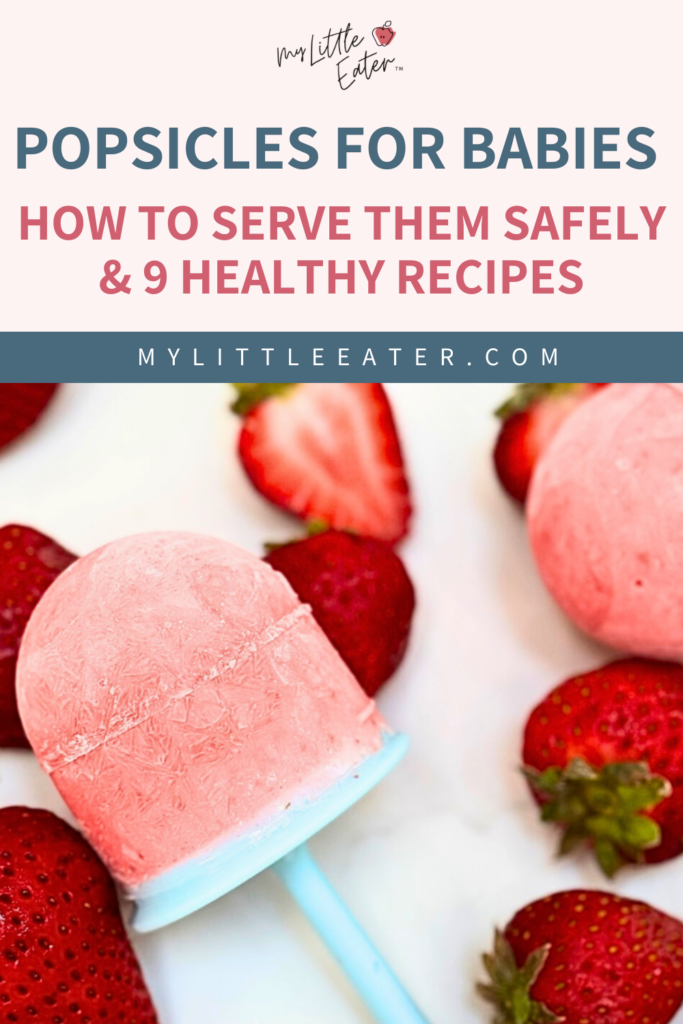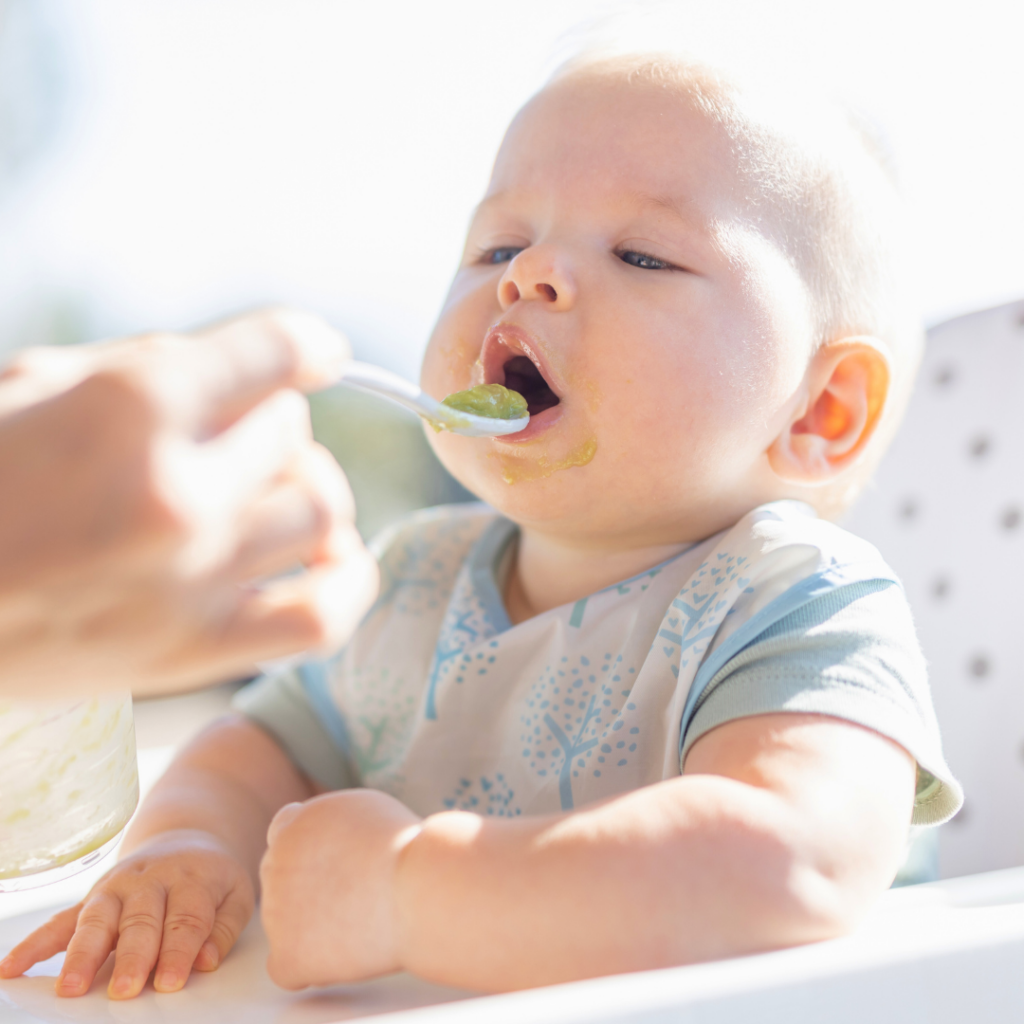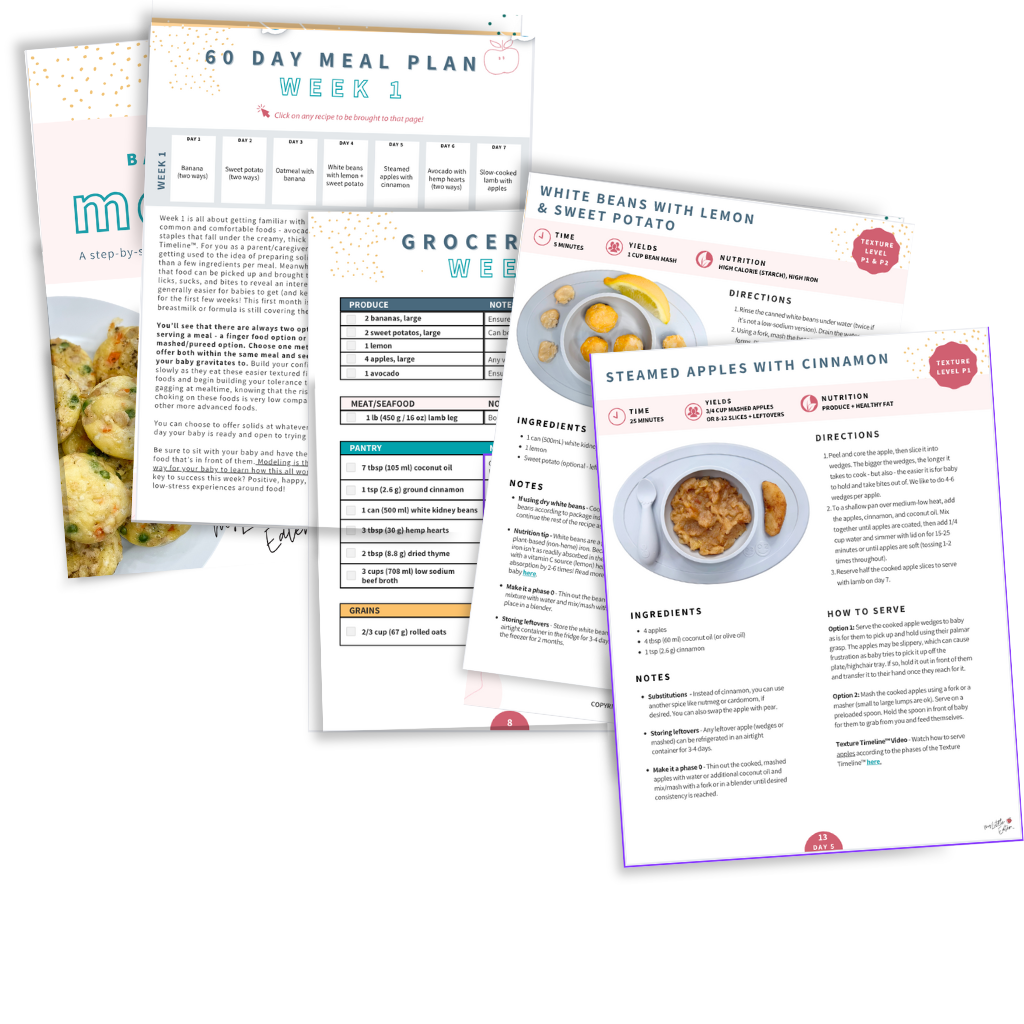This post may contain affiliate links, please view our disclosure policy for more details.
If we were to ask what your favorite summer treat was as a kid, what comes to mind? Is it popsicles?
It is for us!
Popsicles are a great snack during the hot summer months when you want to make sure more than ever that your little one is well hydrated. They’re also delicious and fun for the whole family to enjoy. But you may be wondering, “Are popsicles safe for my baby?”.
The short answer is yes – but there’s a bit more to it than that! Not every popsicle is safe or appropriate for your baby and we have the solution….
Healthy homemade popsicles!
We’ve created 9 healthy, balanced popsicle recipes that are safe and appropriate for your baby. The popsicles from our recipes below can be offered as snacks, or dare we say, as breakfast. And they aren’t just for your baby. These popsicles will be a family favorite everyone can enjoy – including you!
Keep reading to grab the recipes and find out everything you need to know about popsicles for your baby. We answer all your questions like when popsicles are safe to introduce to babies, how to make the healthiest options with My Little Eater’s popsicle formula, what popsicle molds are best, and more!
Get ready to enjoy your family’s new summer obsession – homemade popsicles!
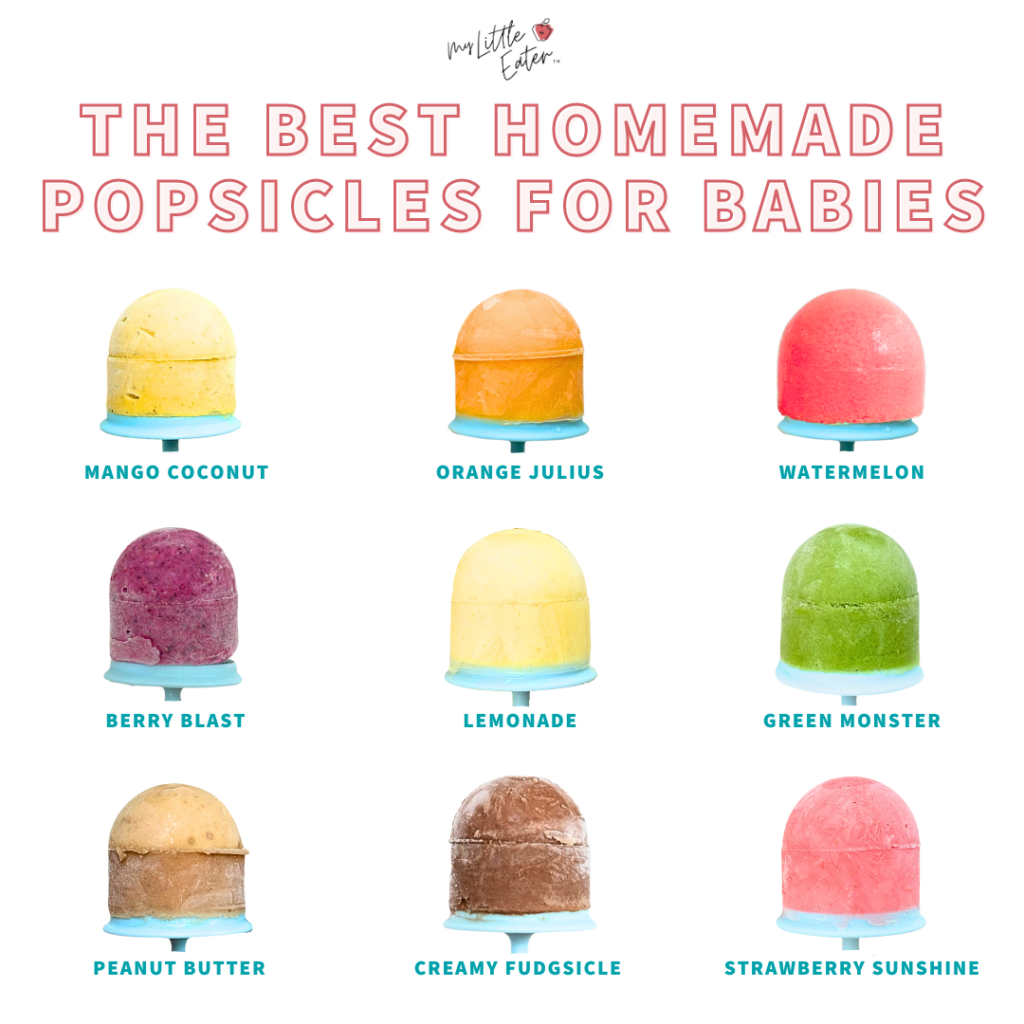
Table of Contents
If you’re someone who likes to print your favorite recipes or keep all of them in one easy-to-access spot, click the button below to download our Popsicle Recipes for Babies e-book!
Complete with all of the recipes you’ll find throughout this blog, but in one convenient download so you can save them and access them as often as you’d like!
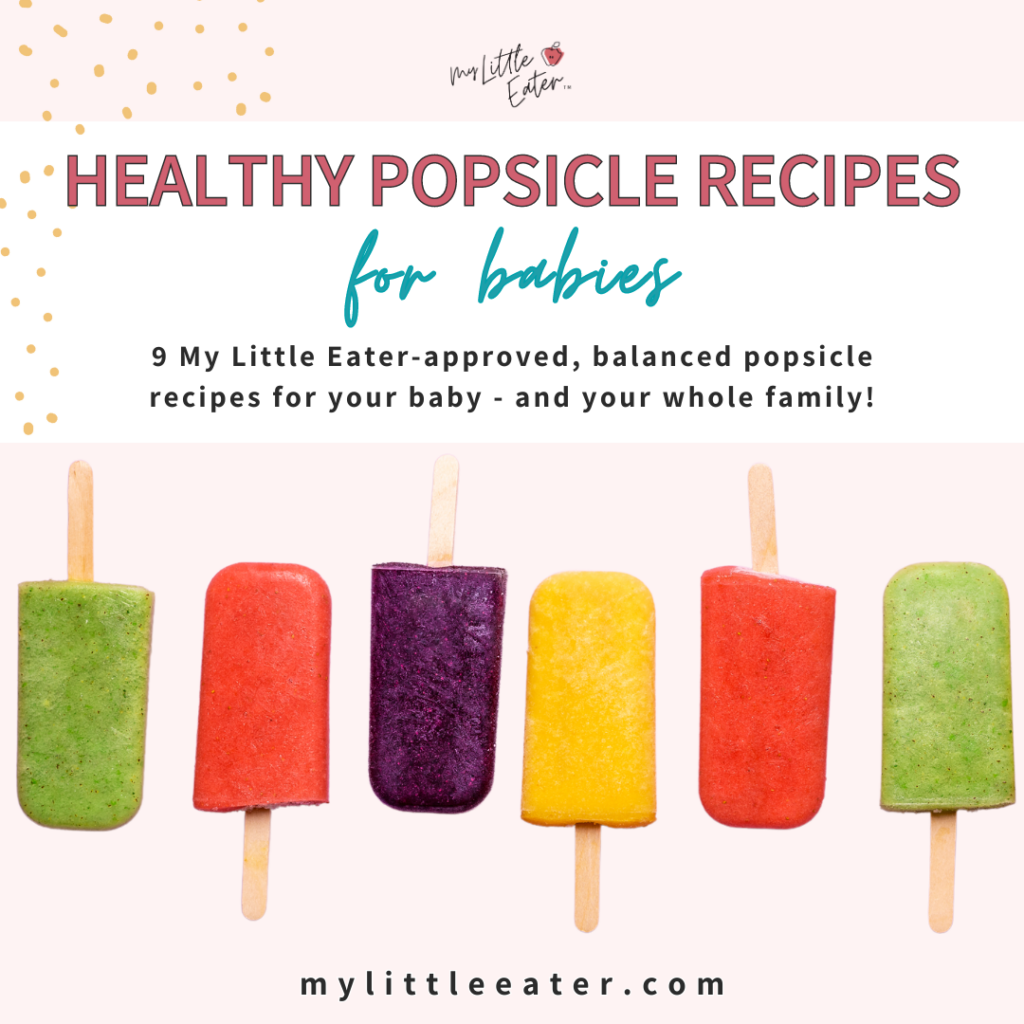
When can babies have popsicles?
We typically recommend waiting until your baby shows all the developmental signs of readiness to start solids before offering popsicles – this is typically around 6 months old (1). But there’s one exception to that rule!
Babies 4-6 months+ old can have popsicles that are made solely from breast milk or formula with no other ingredients added. This is because breast milk and formula are the only foods and fluids required for babies until 6 months (2).
If other foods are added, such as strawberries or yogurt, it can displace breast milk or formula from your baby’s diet, decreasing their overall intake – which we don’t want.
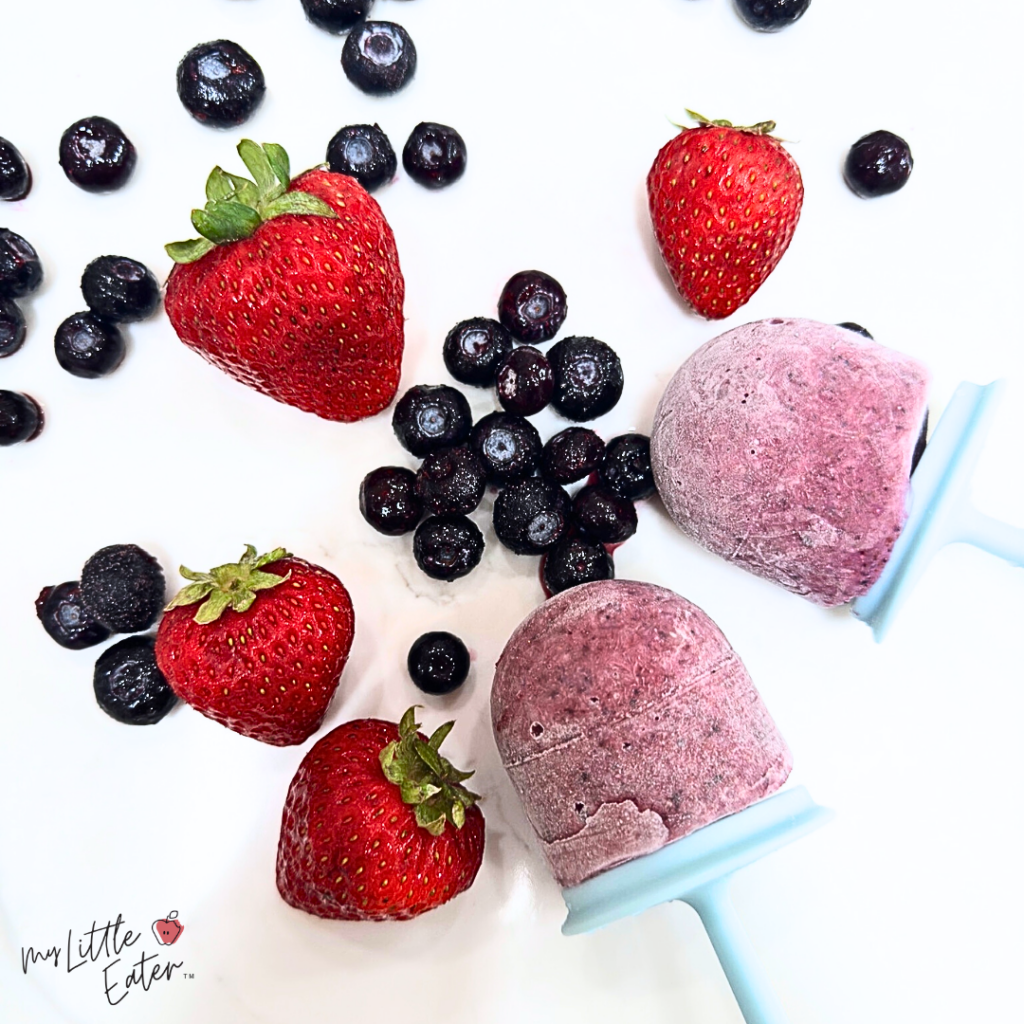
We also don’t want to count popsicles towards their overall milk volume for the day because they may not consume much. Babies will most likely gnaw on the popsicle, with much of it melting and dripping all over the place.
This is why we recommend viewing popsicles before 6 months as a tool for soothing sore gums during teething and not as a way to add nutrition or “meals” to your baby’s diet.
Babies 6 months+ old can eat popsicles with various ingredients from day one of starting solids.
Are popsicles a choking hazard for babies?
Popsicles are not considered a common choking hazard for babies or toddlers. But, depending on how fast it melts and how much liquid is going into their mouth (as opposed to dripping down their chin!) the excess liquid may result in some coughing or even gagging.
Popsicles are a phase 0 food on our Texture Timeline™. The Texture Timeline™ is our signature tool to help guide you to advance your baby from purees to finger foods with confidence.
Because popsicles start to melt as soon as they touch your baby’s mouth, they quickly become thin liquids and don’t require chewing or pressure to dissolve. Your baby can use a suckle motion to swallow the liquid, a skill they already know well from drinking breast milk or formula.
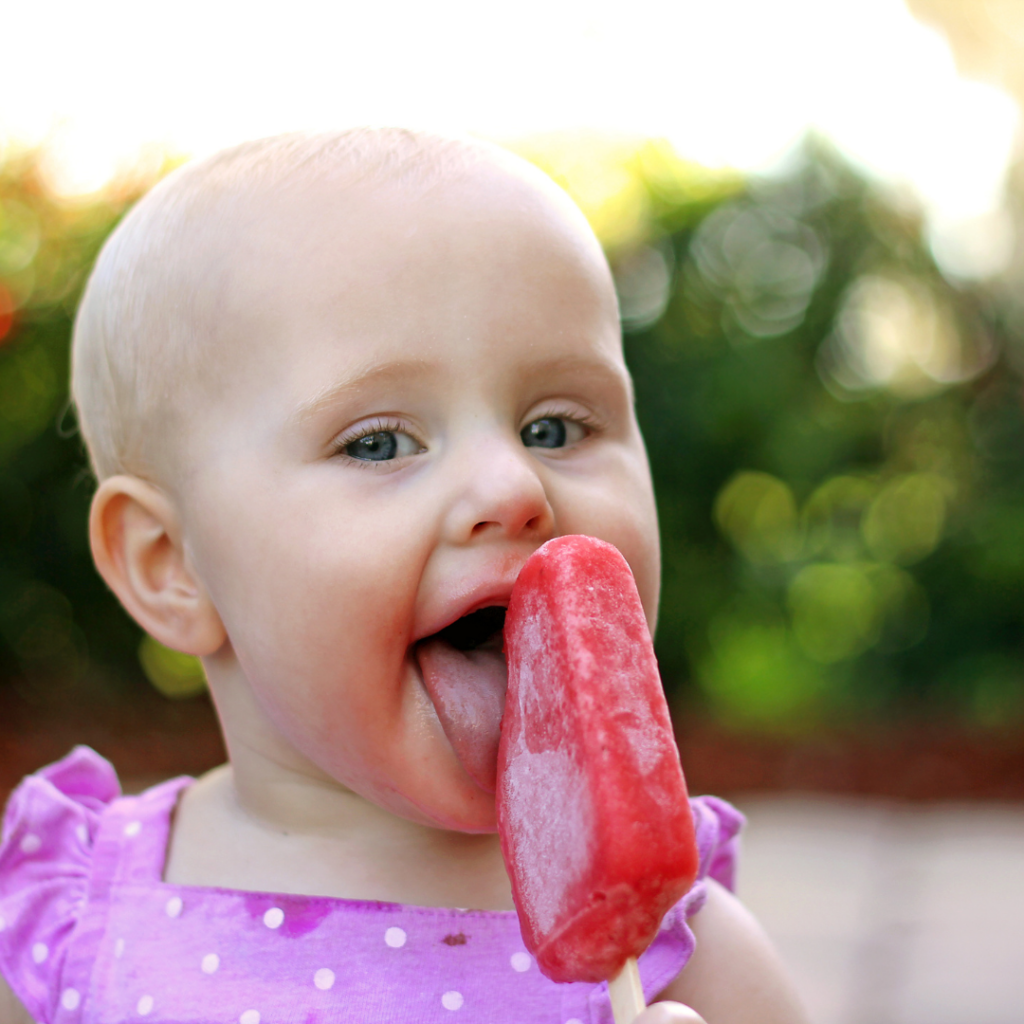
All that said, not all popsicles are appropriate for babies under 2 years old due to their ingredients or size, but we’ll be covering that too – don’t worry!
What to expect when first offering a popsicle to your baby
Popsicles provide a new texture and temperature for your baby making them a new experience for your little one to explore!
However, it might take some time for them to get the hang of how to eat a popsicle. At first, they may suck on them and won’t actually ingest much, so don’t count on them getting many calories from popsicles early on.
Some babies may take well to popsicles at 6 months, other babies may find that popsicles are too cold or too heavy to hold and bring to their mouths, and that’s okay! Every baby is different, so make sure to follow your baby’s cues.
We always recommend babies eat in a safe environment and have constant supervision while eating – the same goes for popsicles! By this, we mean ensuring they are properly seated in a safe position when eating (even if they’re a toddler!). We don’t want them wandering around, playing, running, etc. while eating a popsicle as this increases the risk of choking on any food.
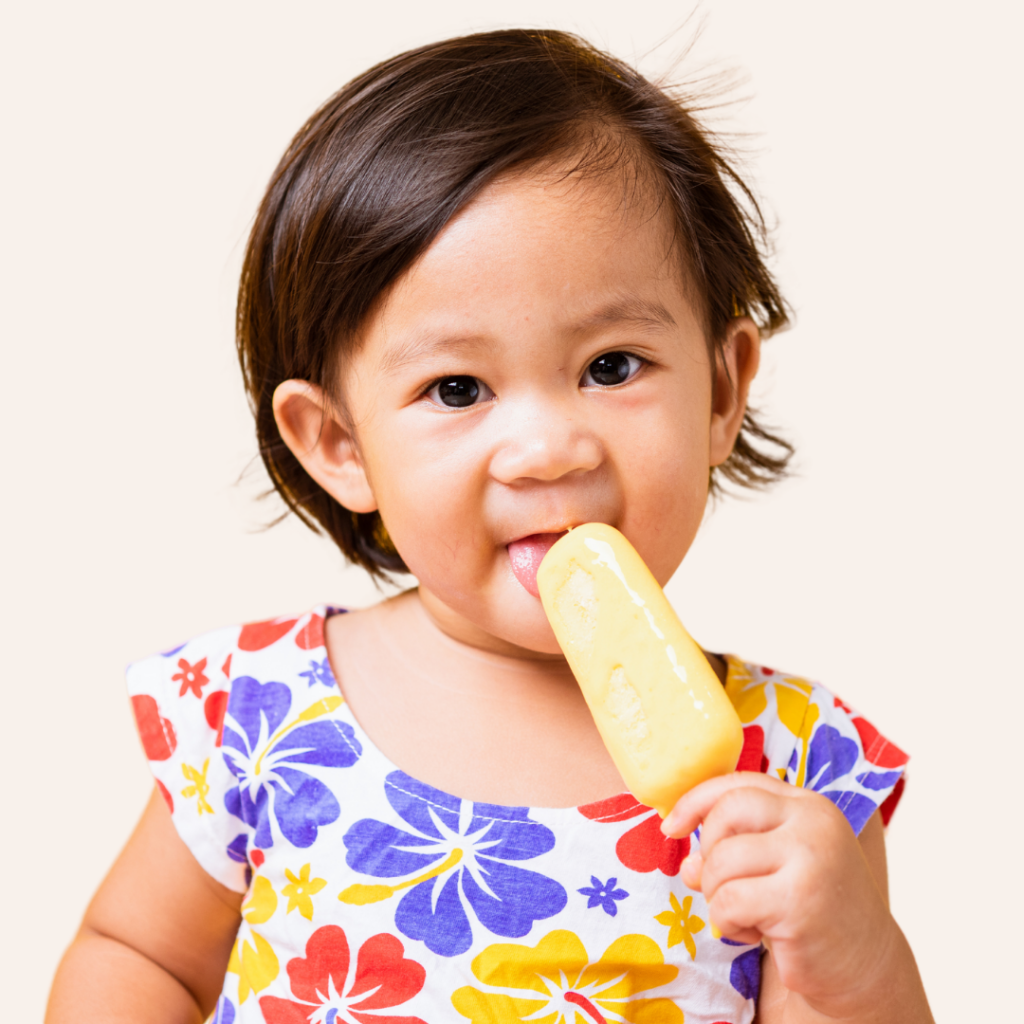
What to expect when first offering a popsicle to your baby
Popsicles provide a new texture and temperature for your baby making them a new experience for your little one to explore!
However, it might take some time for them to get the hang of how to eat a popsicle. At first, they may suck on them and won’t actually ingest much, so don’t count on them getting many calories from popsicles early on.
Some babies may take well to popsicles at 6 months, other babies may find that popsicles are too cold or too heavy to hold and bring to their mouths, and that’s okay! Every baby is different, so make sure to follow your baby’s cues.

We always recommend babies eat in a safe environment and have constant supervision while eating – the same goes for popsicles! By this, we mean ensuring they are properly seated in a safe position when eating (even if they’re a toddler!). We don’t want them wandering around, playing, running, etc. while eating a popsicle as this increases the risk of choking on any food.
Healthy popsicles for your baby
Popsicles are a perfect sweet treat for children (and us adults!). Although they usually have a bad rep for being sugar-filled treats, for babies especially, we can avoid this by eliminating added sugar and the sugar spike that comes with most store-bought popsicles.
That’s why we love homemade popsicles! With these, you can be sure the ingredients are safe and appropriate for your baby while being delicious at the same time. They can also be healthy and provide many beneficial nutrients to your little one. And did we mention how easy they are to make?
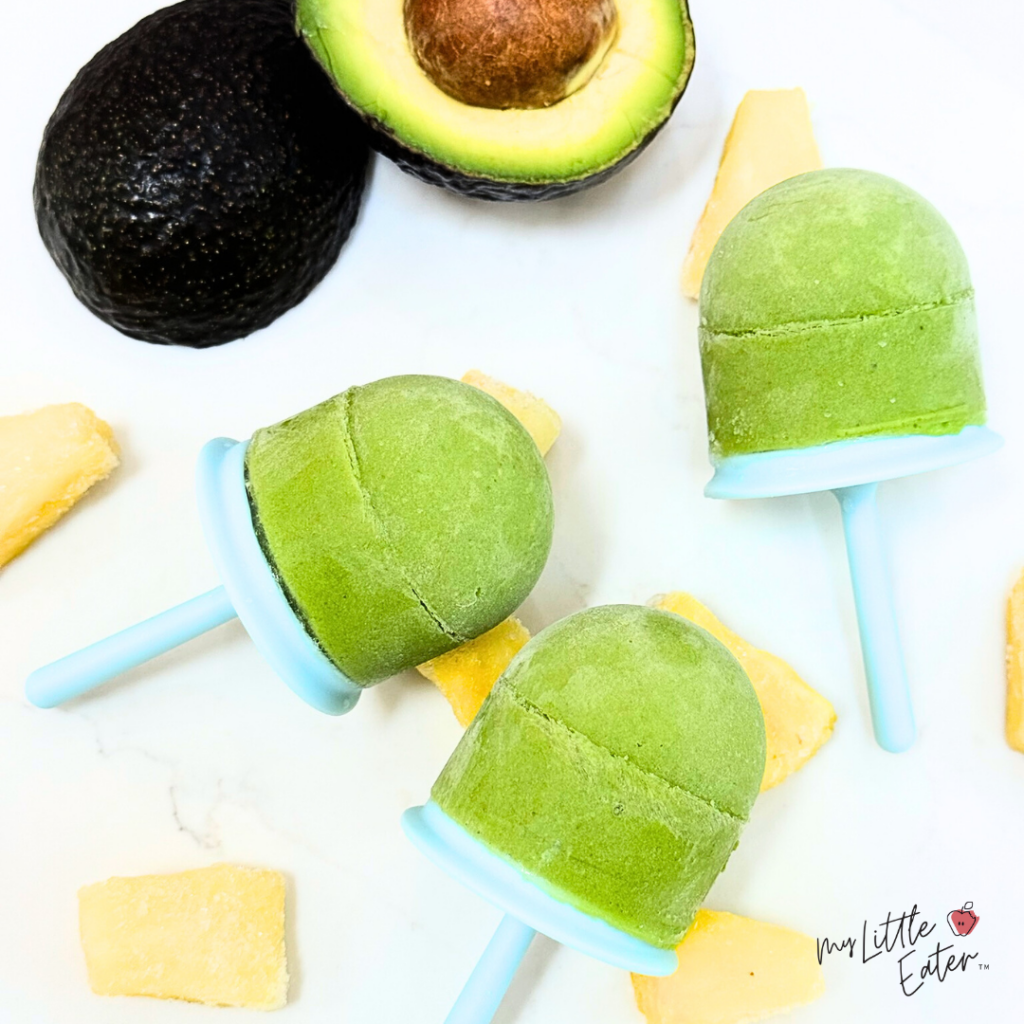
Traditional popsicles from the store are often made from concentrated fruit juice and sugar, which we want to avoid with babies (we’ll talk more about this later). To make healthy popsicles for your baby, we want to follow My Little Eater’s golden rule for creating healthy meals and snacks for children. This is called the FFP rule, which stands for fat, fiber, and protein.
This rule ensures you create a balanced meal for your little one that includes all the essential nutrients for proper growth and development. With a meal, we want to include a source of all three macronutrients (fat, fiber, AND protein). With a snack, we only need two out of three of the macronutrients. For example, fiber and fat, or protein and fiber. The same rule applies to making healthy and balanced popsicles.
For babies especially, we want to prioritize iron, high-caloric foods, and produce. Iron is important for your baby’s brain development, production of healthy red blood cells, and physical growth (3).
Some sources of iron that can be added to popsicles are spinach, cocoa, avocado, hemp seeds, chia seeds, and nuts. Keep reading to see how these foods can be incorporated into a delicious popsicle recipe for your baby!
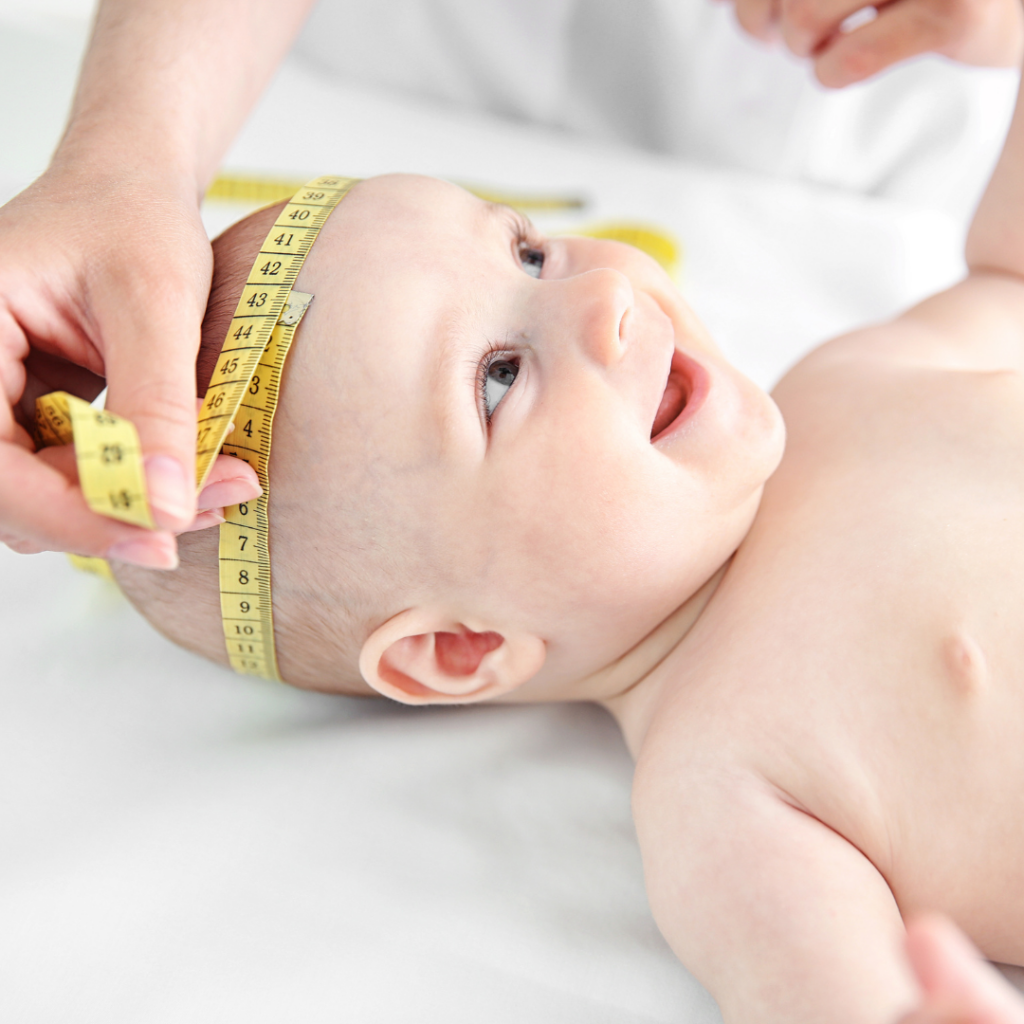
Click on the link below to get our popsicle recipe e-book sent to your email so you can download it on any device and have the recipes at your fingertips!
My Little Eater’s formula for balanced popsicles for babies
We know you’re a busy parent working hard every single day to ensure your little one is as healthy as can be. That’s why we’ve created healthy popsicle recipes for you so that you don’t have to spend your time brainstorming recipes for your baby.
If you’re someone who likes to experiment and wants specialized guidance, we’ve also created our very own signature formula for making healthy homemade popsicles for your baby. It follows the FFP rule mentioned above to make sure the popsicles are well-balanced for your little one.
Now, this isn’t to say that you can’t make a simple blended fruit popsicle with one ingredient that isn’t completely balanced. You certainly can, but it’s always good to mix it up with different foods and flavors. With our formula, you can rest easy knowing that you’re providing a healthy snack (or meal!) for your baby (and often won’t even have to serve anything else on the side!).
Let’s break this formula down in more detail!
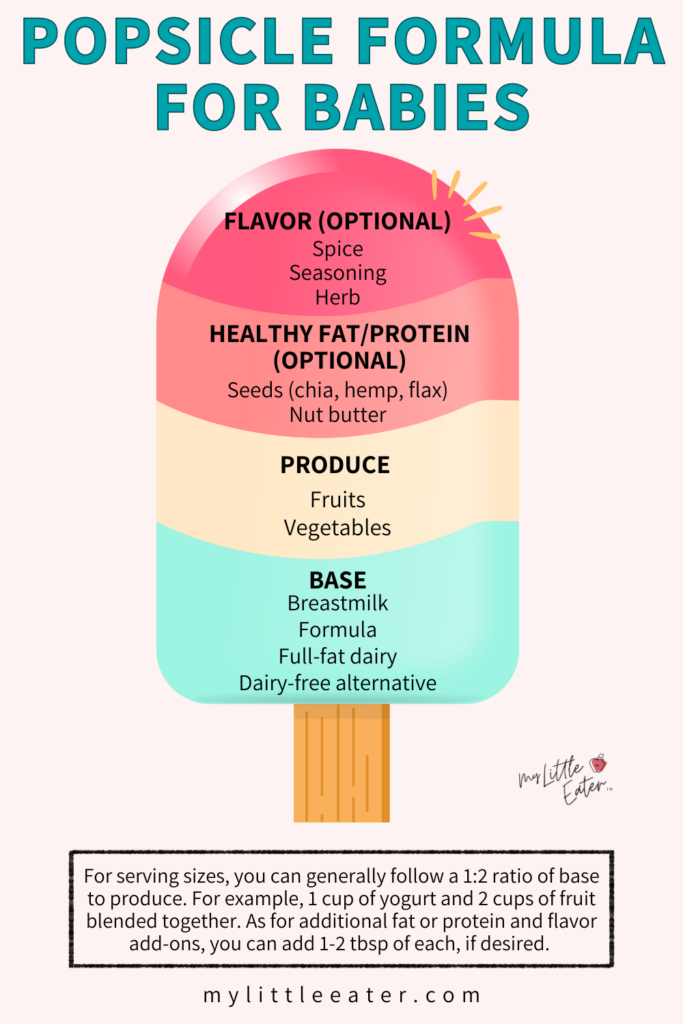
Base
The base in our popsicle formula is generally a dairy source or an alternative. This base provides a nice, creamy texture to the popsicle, pairs well with the produce, helps to balance your baby’s blood sugar levels, and will keep them full for longer. Feel free to use breast milk, formula, cow’s milk, full-fat yogurt, or a dairy-free alternative.
If you’d like to use a dairy-free milk alternative, we want the milk to provide a good source of fat and protein for your baby. Fat is particularly important for the proper development of babies’ brains, so we try to prioritize that when possible.
Dairy-free milks that would not be good choices in this case are almond milk, coconut milk, rice milk, hemp milk, or cashew milk as these provide little fat or protein for your baby. They will still make a delicious popsicle, but won’t be as nutrient-dense! Our top choices would be soy milk, oat milk, or fortified Ripple Milk.
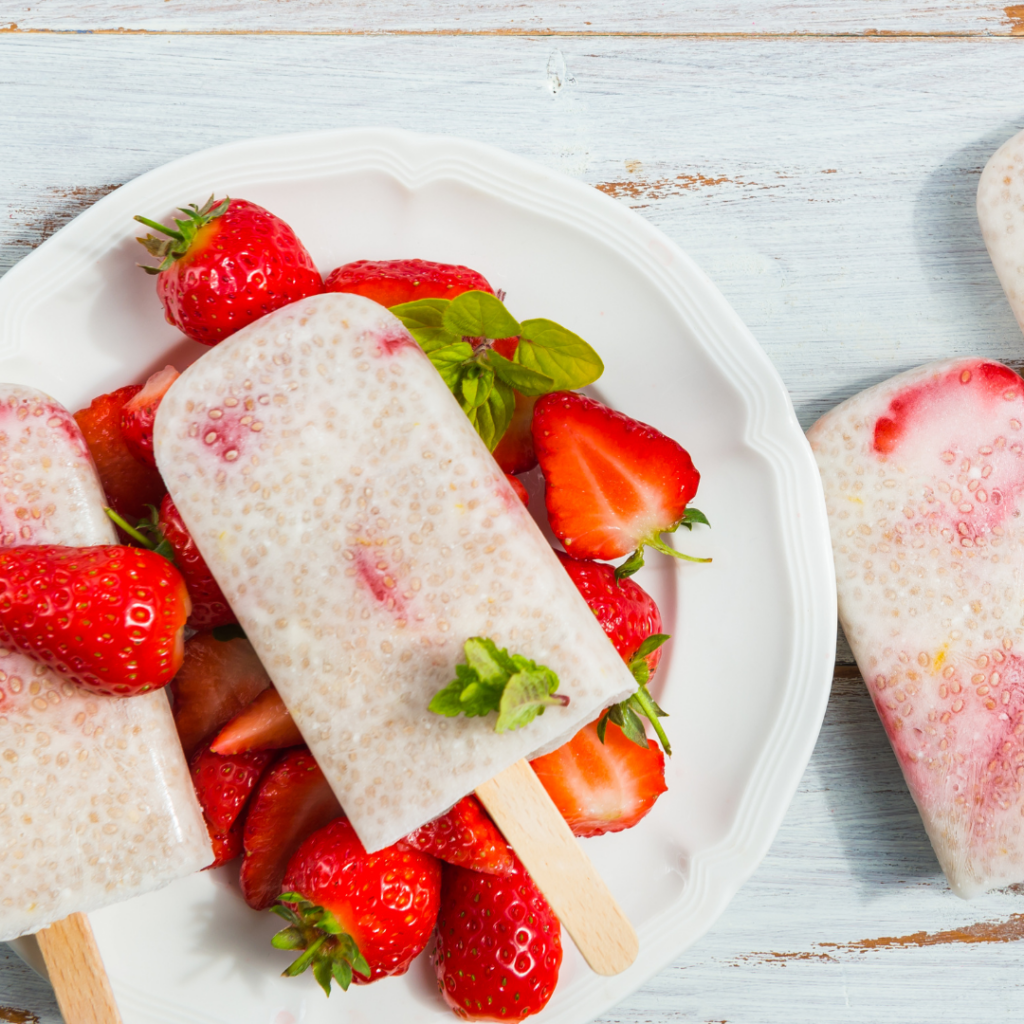
For babies especially, we also want to prioritize high-iron foods for proper growth and development. Using an iron-fortified formula will help to ensure there’s a good source of iron in the popsicle too.
Produce
Produce includes fruit and vegetables. You can add fruits or vegetables by blending them into a puree to add to the recipe, or you can mash them for a more textured popsicle. Fruits and veggies are great popsicle ingredients as they’re loaded with vitamins, minerals, antioxidants, and fiber!
We’re sure you’ve heard all the hype about fiber being beneficial to feed the good bacteria in your gut. Well, it’s also important for children too. Fiber helps to promote healthy bowel function and may help to prevent constipation (4, 5).
Mixing up the color of the popsicles from different fruits and vegetables also helps expose your baby to a variety of foods early on. This increases the chance that your baby will be more open to trying different fruits and veggies in toddlerhood (when the pesky picky eating starts to show up).
Fat or protein (optional)
To provide further nutrition to your baby, you can also add in an extra source of fat and protein to give it a boost of nutrients. This could be a nut butter or seeds, such as chia, hemp, or flax seed.
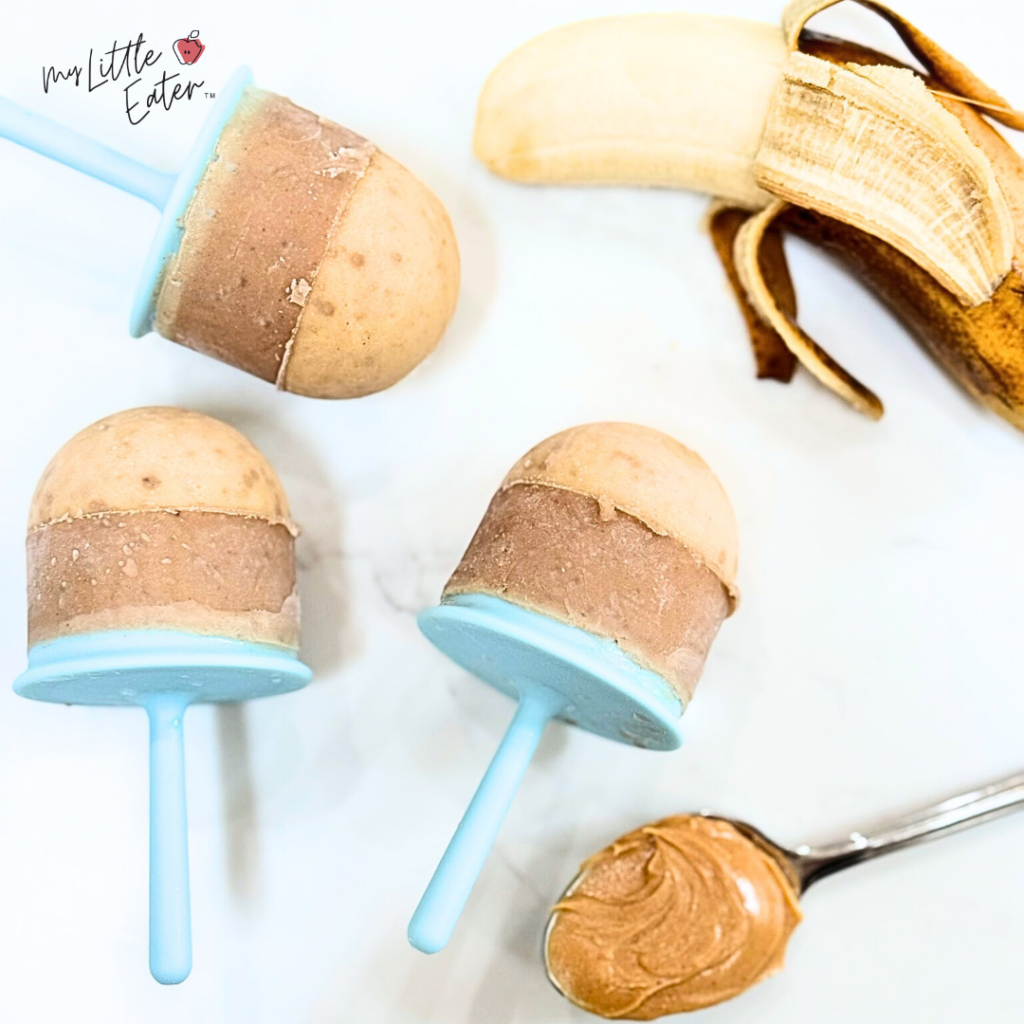
This addition makes the popsicles more filling and further helps to avoid the rise in blood sugar levels that we often see with store-bought popsicles. Even though the base also provides a healthy source of fat or protein, it may not provide a source of iron.
For example, dairy products often don’t contain iron. The addition of a seed or nut butter will add a source of iron to the popsicles, which is very important for your baby, as mentioned above.
If you choose to use a base that doesn’t provide a significant source of fat or protein, adding in some nut or seed butter is especially helpful!
Flavor add-ons (optional)
Adding spices, seasonings, or fresh herbs to a popsicle is our secret tool to help expose your baby to new flavors in a FUN and enticing way. You can get creative with finding delicious pairings for popsicles, such as turmeric with orange, lemon with coconut, or fresh mint with strawberries. Yum!
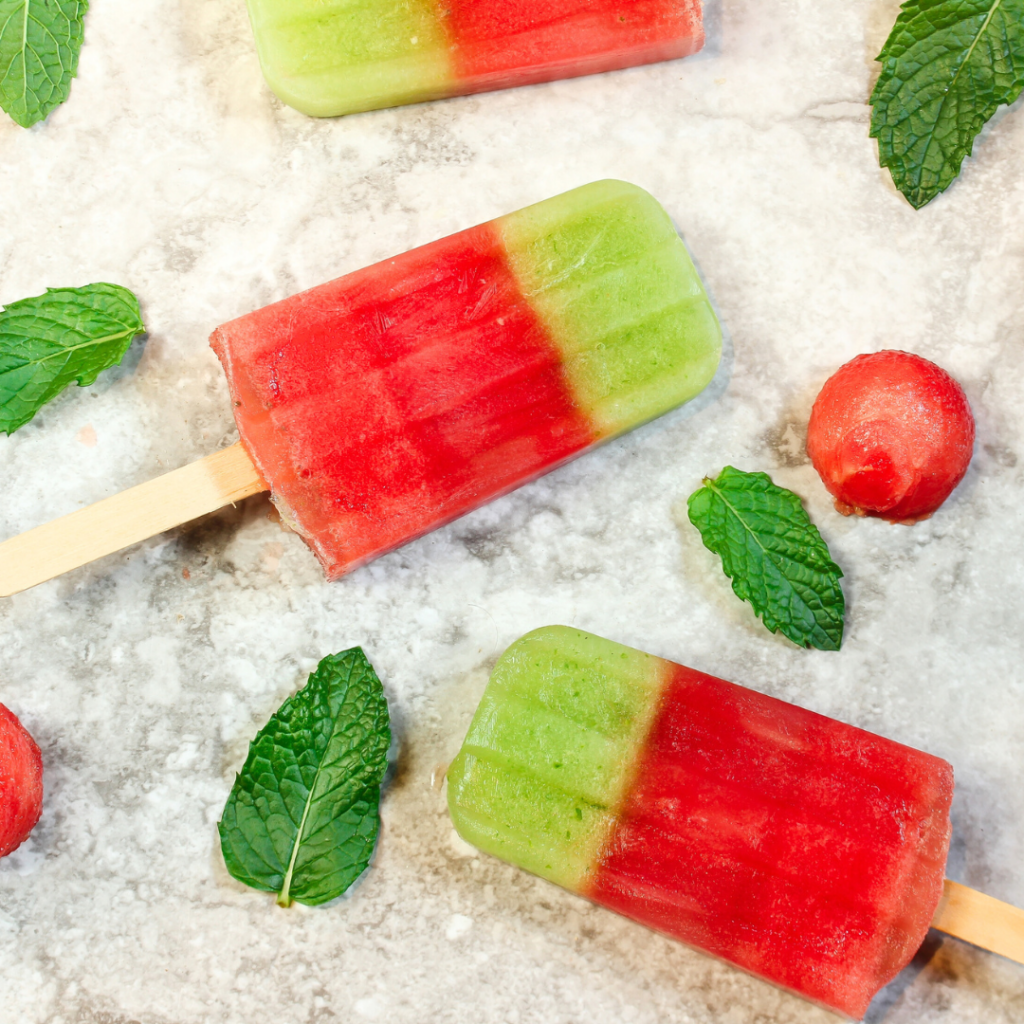
We’ve created a list of our favorite popsicle ingredients for each of these categories to provide a nutritional boost and a variety of flavor exposures. Try endless combinations of popsicles using our mix-and-match table below.
Enjoy!
For serving sizes, you can generally follow a 1:2 ratio of base to produce. For example, 1 cup of yogurt and 2 cups of fruit blended together. As for additional fat/protein and flavor add-ons, you can add 1-2 tbsp of each, if desired.
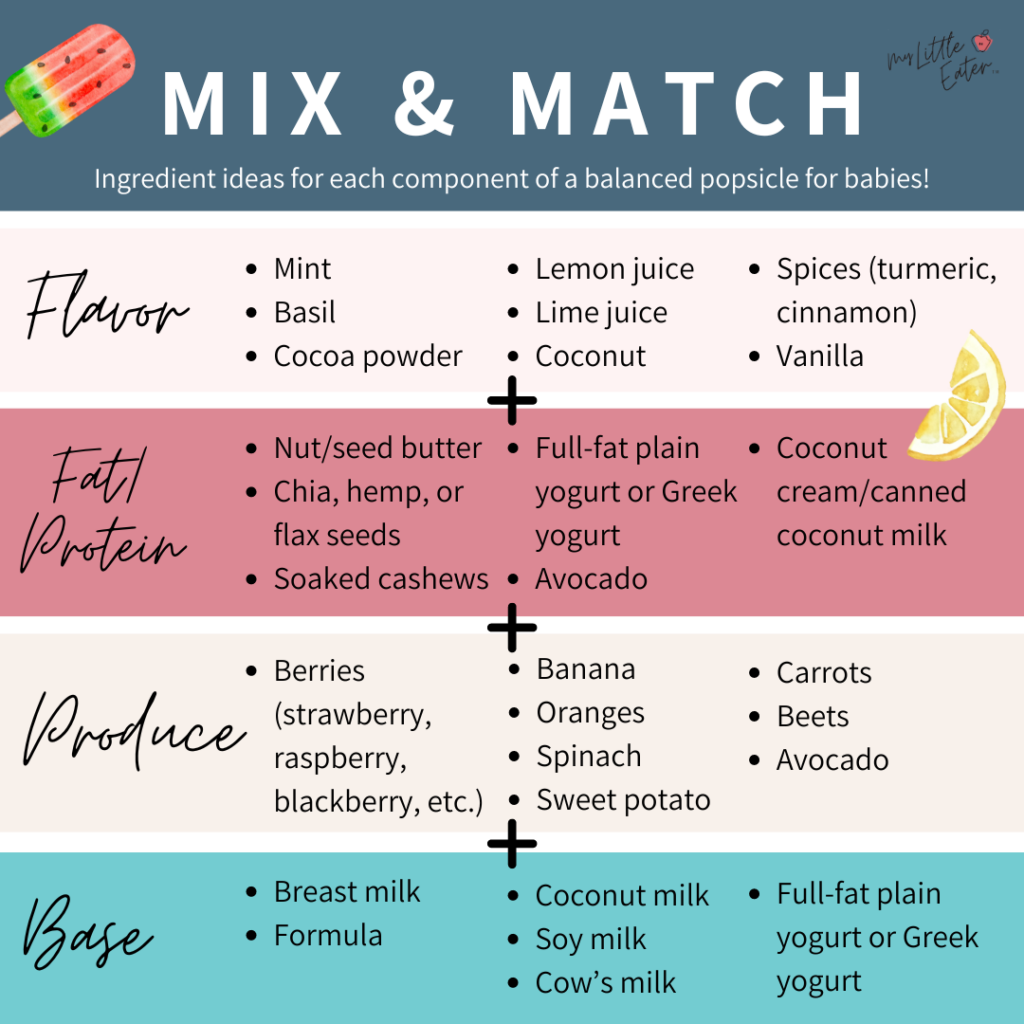
Homemade popsicle recipes for babies
Here are 9 My Little Eater-approved, balanced popsicle recipes for your baby – and your whole family! You can view the recipes below, or download the free popsicle recipe guide for babies.
And if you’re looking for molds to make these popsicles an appropriate size for your baby, keep reading for a list of our recommended popsicle molds!
Let us know which is your favorite recipe in the comments below – we’d love to hear from you!
Mango Coconut
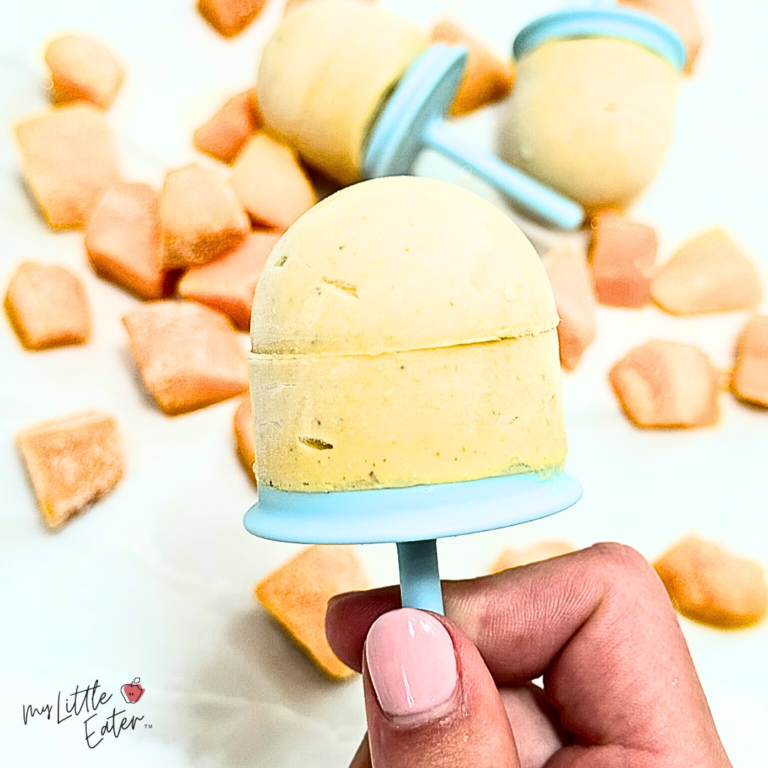
Mango Coconut Popsicle
Equipment
- 1 blender
Ingredients
- 1 cup unsweetened coconut milk
- 2 cups frozen mango
- 3 tbsp hemp seeds
Instructions
- Blend the mango, milk, and hemp seeds together in a blender until you have a puree.
- Pour the blended popsicle mixture into your popsicle molds. Leave a ¾ inch gap between the liquid and the lid to allow for expansion.
- Add the lid to each popsicle mold and then freeze it for 2-3 hours or until fully frozen.
Notes
Orange Julius
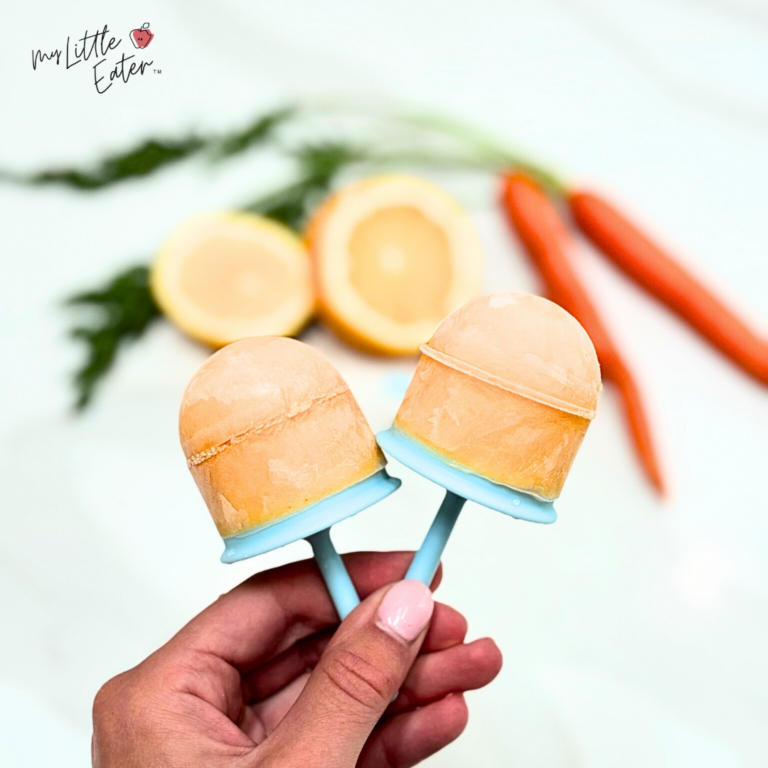
Orange Julius Popsicle
Equipment
- 1 blender
- 1 Pot
Ingredients
- 1 cup yogurt (full-fat, unsweetened)
- 1 carrot (small, peeled, and chopped)
- 1 ½ cups orange juice, or 5-6 large fresh oranges, juiced
- 1 tsp vanilla extract
Instructions
- Add the carrots to a small pot of boiling water. Cook for 8-10 minutes or until very tender. Drain.
- Add the orange juice, yogurt, cooked carrots, and vanilla extract to a blender and blend until very smooth and creamy.
- Pour the blended orange popsicle mixture into a popsicle mold. Leave a ¾ inch gap between the liquid and the lid to allow for expansion. Add the lid to each popsicle mold and then freeze it for 2-3 hours or until fully frozen.
Notes
Watermelon
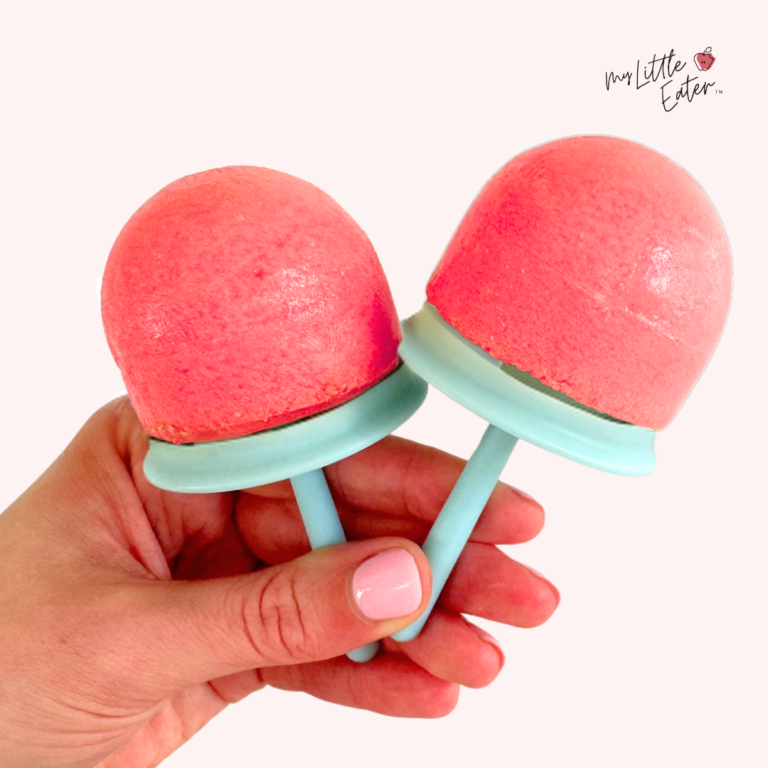
Watermelon Popsicles for Babies
Equipment
- 1 blender
Ingredients
- 2 ½ cups pureed watermelon
- 1 cup full-fat coconut milk
Instructions
- Cut up the watermelon into chunks and remove any black seeds.
- Put the watermelon and coconut milk into a high-powered blender and blend until you have a puree.
- Pour the watermelon popsicle mixture into six popsicle molds. Leave a ¾ inch gap between the liquid and the lid to allow for expansion. Add the lid to each popsicle mold and then freeze it for 2-3 hours or until fully frozen.
Notes
Berry Blast

Berry Blast Popsicle
Equipment
- 1 blender
Ingredients
- 1 cup milk*
- 1 ½ cup mixture of any of the following berries you have on hand: strawberries, blueberries, raspberries, cherries, blackberries (fresh or frozen)
- 1-2 tbsp lemon juice (approximately ½ a lemon, juiced)
- 2 tbsp chia seeds
Instructions
- Place all the ingredients in a blender and blend until smooth and creamy.
- Pour the blended berry popsicle mixture into a popsicle mold. Leave a ¾ inch gap between the liquid and the lid to allow for expansion.
- Add the lid to each popsicle mold and then freeze it for 2-3 hours or until fully frozen.
Notes
Lemonade
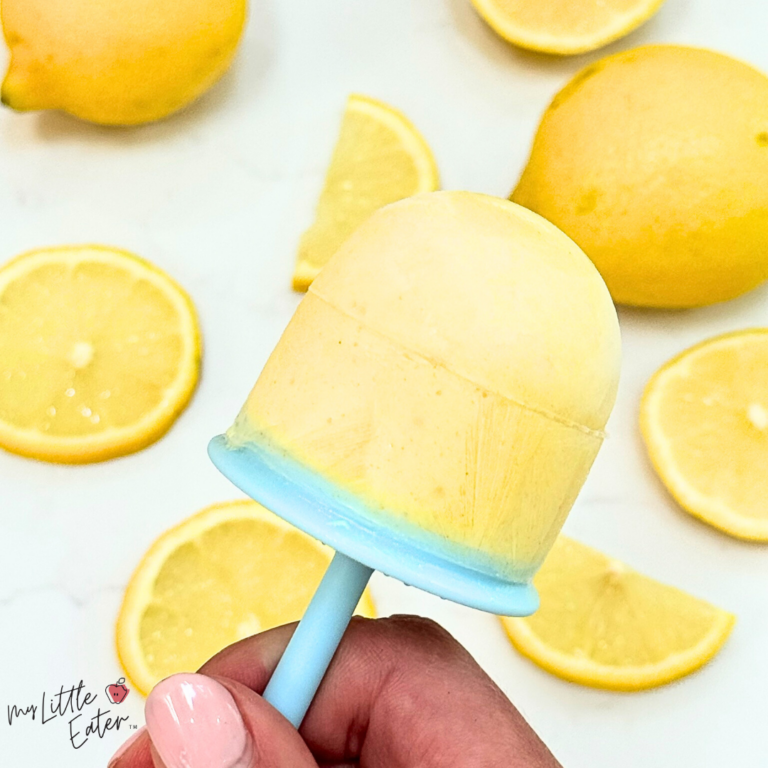
Lemonade Popsicle
Equipment
- 1 blender
Ingredients
- 1 ½ cup yogurt
- ¼ cup lemon juice
- ½ tsp turmeric powder
- 1 tbsp chia seeds
Instructions
- Place all the ingredients in a blender and blend until smooth and creamy.
- Pour the blended lemonade popsicle mixture into a popsicle mold. Leave a ¾ inch gap between the liquid and the lid to allow for expansion.
- Add the lid to each popsicle mold and then freeze it for 2-3 hours or until fully frozen.
Notes
Green Monster
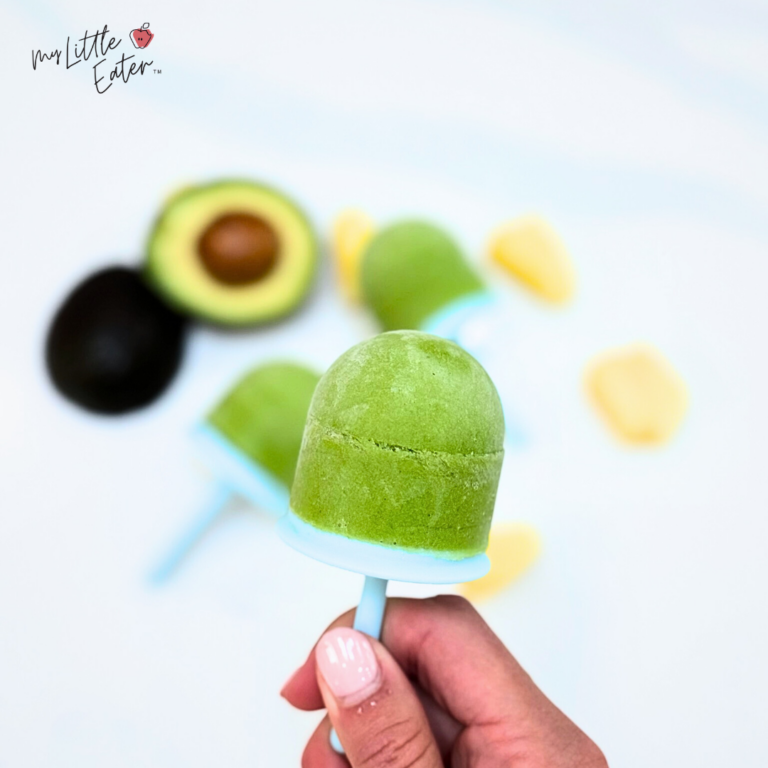
Green Monster
Equipment
- 1 blender
Ingredients
- 1 cup milk*
- ¾ cup fresh spinach
- 1 cup pineapple
- 1 avocado, pitted
- Optional add-in Fresh mint leaves
Instructions
- Place all the ingredients in a blender and blend until smooth and creamy.
- Pour the blended popsicle mixture into a popsicle mold. Leave a ¾ inch gap between the liquid and the lid to allow for expansion.
- Add the lid to each popsicle mold and then freeze it for 2-3 hours or until fully frozen.
Notes
Peanut Butter Pops
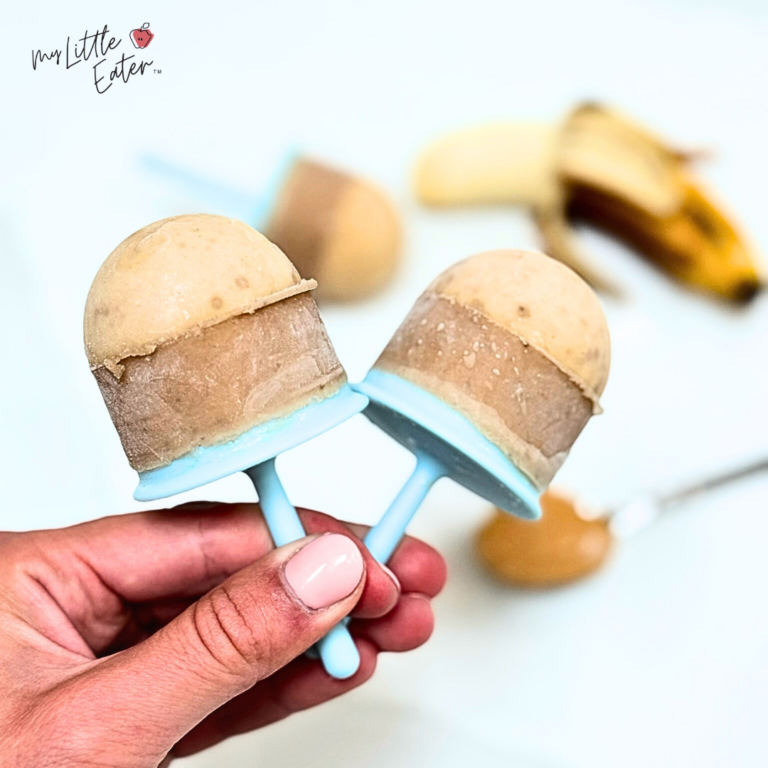
Peanut Butter Pops
Equipment
- 1 blender
Ingredients
- ½ cup milk*
- 3 ripe bananas
- ¼ cup natural peanut butter
- ½ tsp vanilla extract
Instructions
- Place all the ingredients in a blender and blend until smooth and creamy.
- Pour the blended popsicle mixture into a popsicle mold. Leave a ¾ inch gap between the liquid and the lid to allow for expansion.
- Add the lid to each popsicle mold and then freeze it for 2-3 hours or until fully frozen.
Notes
Creamy Fudgsicle
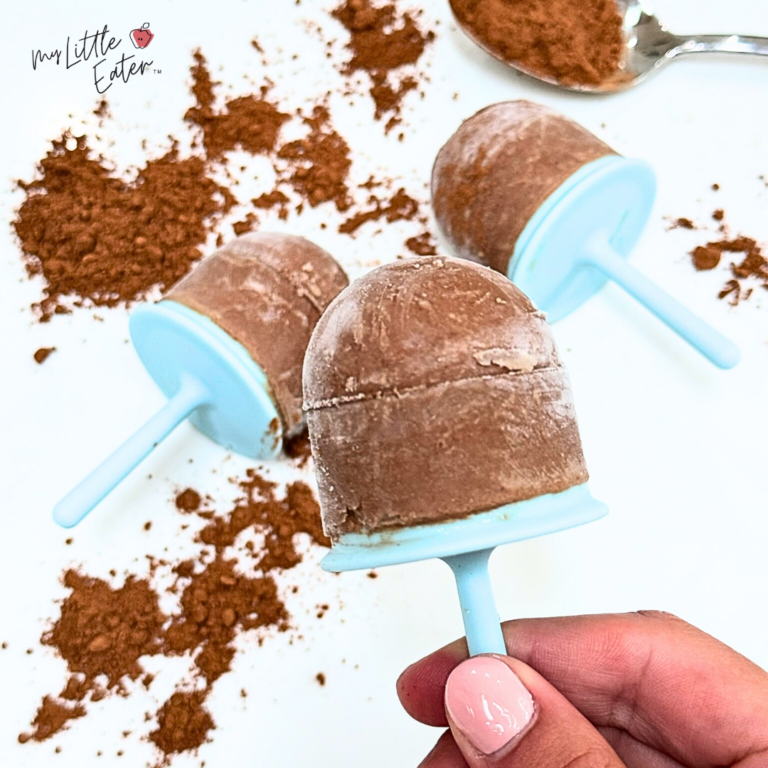
Creamy Fudgsicle
Equipment
- 1 blender
Ingredients
- 1 ripe banana
- ½ cup yogurt
- ½ cup milk* ℉
- 3 tbsp unsweetened cocoa powder
- 2 Medjool dates, pitted
- ½ tsp vanilla extract
Instructions
- Place all the ingredients in a blender and blend until smooth and creamy.
- Pour the chocolatey popsicle mixture into a popsicle mold. Leave a ¾ inch gap between the liquid and the lid to allow for expansion.
- Add the lid to each popsicle mold and then freeze it for 2-3 hours or until fully frozen.
Notes
Strawberry Sunshine
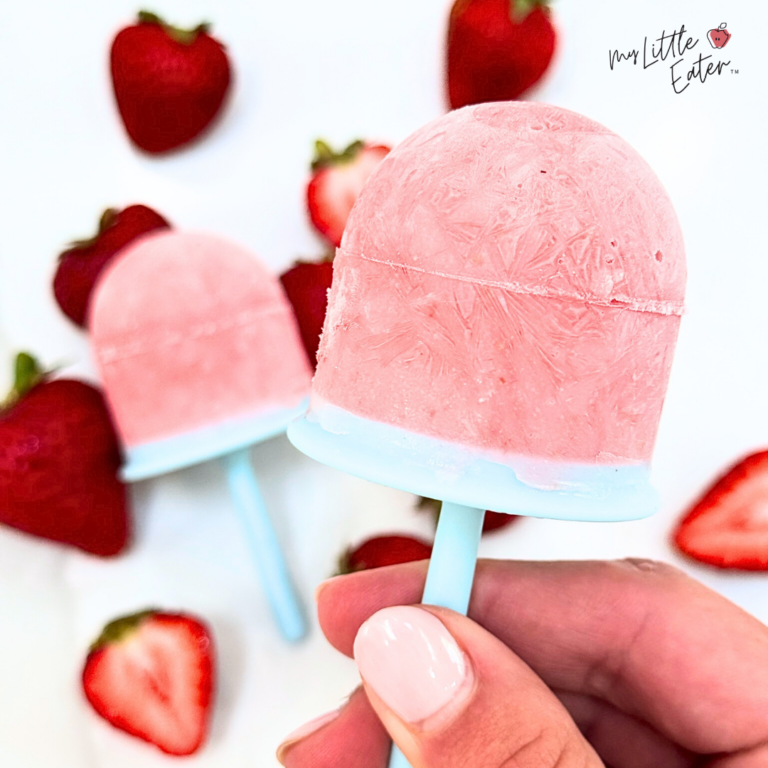
Strawberry Sunshine Popsicle
Equipment
- 1 blender
Ingredients
- 1 cup yogurt
- 1 ½ cups strawberries (fresh or frozen)
- ¼ cup orange juice
- 1-2 tbsp lemon juice (approximately 1/2 lemon, juiced)
- 1 tsp hemp seeds (optional add-in)
Instructions
- Place all the ingredients in a blender and blend until smooth and creamy.
- Pour the blended strawberry popsicle mixture into a popsicle mold. Leave a ¾ inch gap between the liquid and the lid to allow for expansion.
- Add the lid to each popsicle mold and then freeze it for 2-3 hours or until fully frozen.
Notes
Choosing a popsicle mold
To make the recipes we’ve provided, you’ll need to purchase some molds specifically designed for babies. There are a couple of things to consider when buying baby-appropriate popsicle molds, let’s go over what we recommend.
Silicone vs. plastic
This is the big question on everyone’s mind when deciding what type of popsicle mold to buy, or really when purchasing anything for your baby.
Traditionally, plastic has been the main option when buying popsicle molds. But, in recent years, more information has come out on plastic and its potential health risks, so more companies have started to create silicone options.
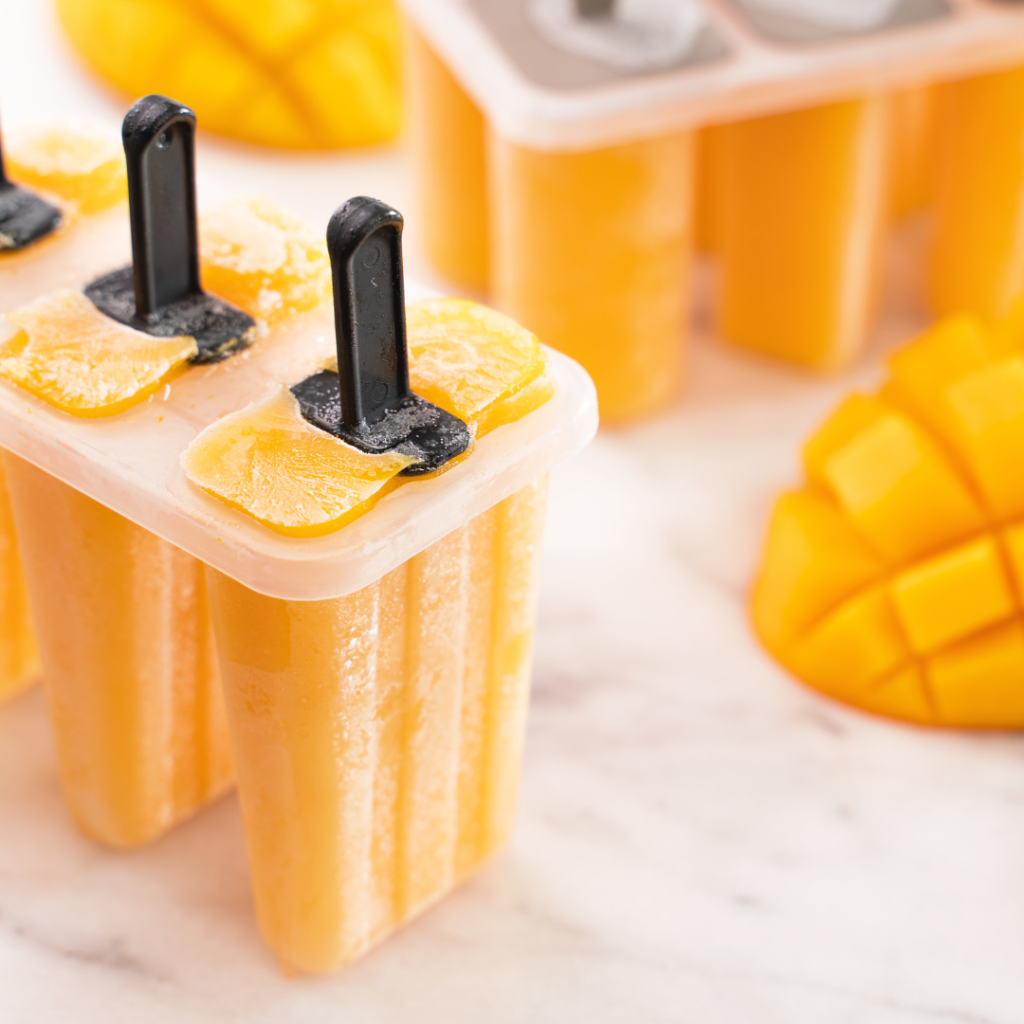
Plastic popsicle molds
Some hard plastics contain a chemical called Bisphenol A (BPA) which is hazardous to humans (6). Babies can be especially sensitive to its effects. If buying a plastic popsicle mold, you’ll want to make sure it’s BPA-free.
One of the downsides of plastic popsicle molds is that they’re not flexible. After freezing your popsicles, the mold will be hard and rigid, making it difficult to remove the popsicle from the plastic.
If you decide to go with plastic, we have a trick to help with this! Once you take the popsicles out of the freezer, quickly run the popsicle mold under warm water to help loosen the popsicles from the mold.
Silicone popsicle molds
Silicone is a flexible material which makes it really easy to remove the popsicles from the mold once they’re ready, as opposed to plastic molds. Silicone is a strong and sturdy material, so it may last longer than plastic.
Now, you may have heard about “food grade” silicone and wonder if this is what you should be looking for. Silicone is used in a wide range of products, and not all silicone products out there are food-grade. For example, silicone is used for industrial purposes, medical purposes, or with food products (7).
Anything that comes into contact with food must be food-grade silicone. This ranges from food containers and baby soothers to straws and popsicle molds. Food-grade is high quality and non-toxic, and is created to be a smooth product with excellent toughness and elasticity (7).
To ensure the product you want to purchase is safe to use with food, the product should be labelled as “food-grade” or “FDA approved”.
Takeaway: Both plastic and silicone popsicle molds can be good choices. If buying a plastic mold, make sure it’s BPA-free. If buying a silicone mold, make sure it’s labeled as food-grade or is FDA approved. Silicone products may be easier to use for a popsicle mold, with greater durability.
Size
As we mentioned before, large popsicles made with small, skinny handles can be really difficult for your baby to hold and eat. For babies, we want a popsicle mold with a larger handle that is easy to grip with their palmar grasp.
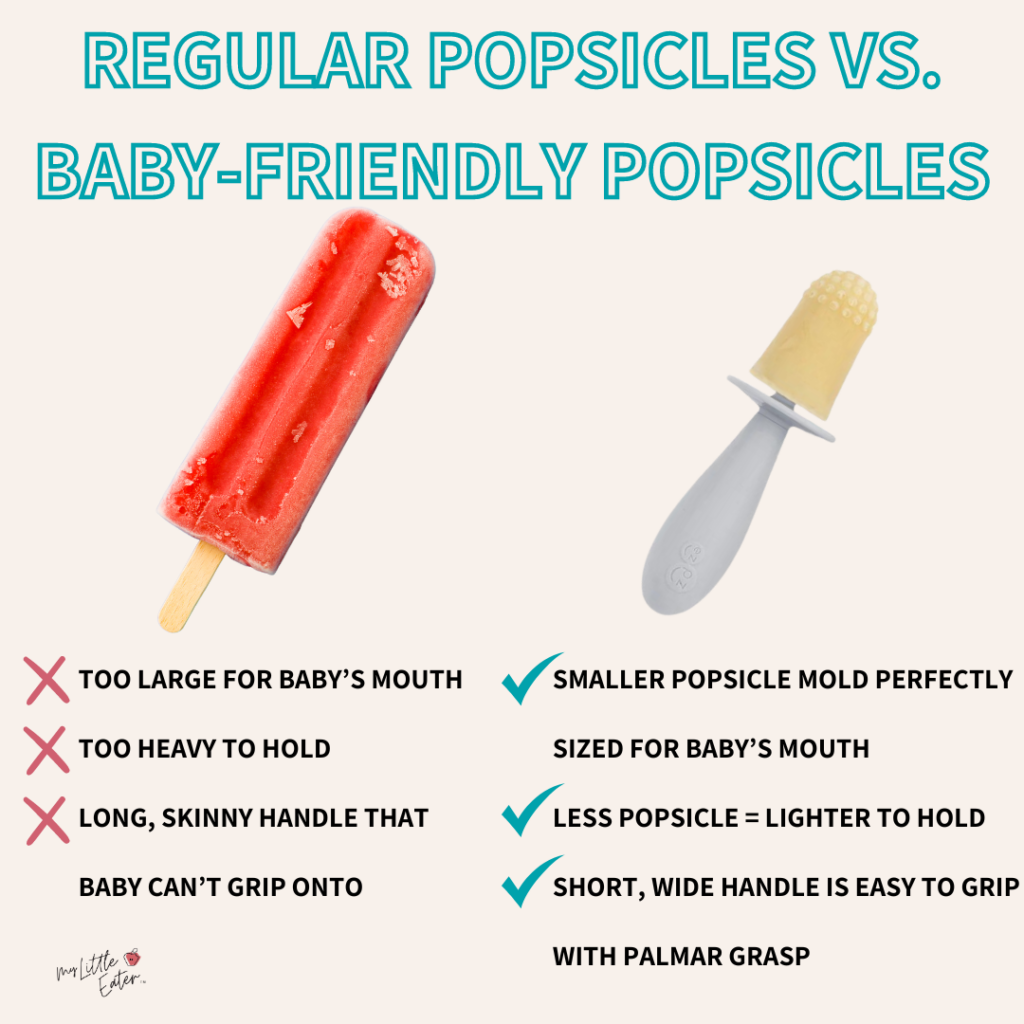
We also want the actual mold to be smaller to better fit into your baby’s mouth. A smaller popsicle mold will also make sure the overall popsicle is not too heavy for your baby to hold.
Top baby popsicle mold brands
Here are our favorite recommended popsicle molds for babies!
Ezpz Tiny Pops
These silicone popsicle molds were created specifically for babies. They hold ½ oz which is the perfect size to fit your baby’s small mouth. The Tiny Pops have short, round handles which are easier for your baby to hold onto.
What’s even better is this popsicle mold was designed by a Pediatric Feeding Specialist. It has tiny little frozen sensory bumps on the top of the popsicle to provide increased oral awareness and stimulation for your baby.
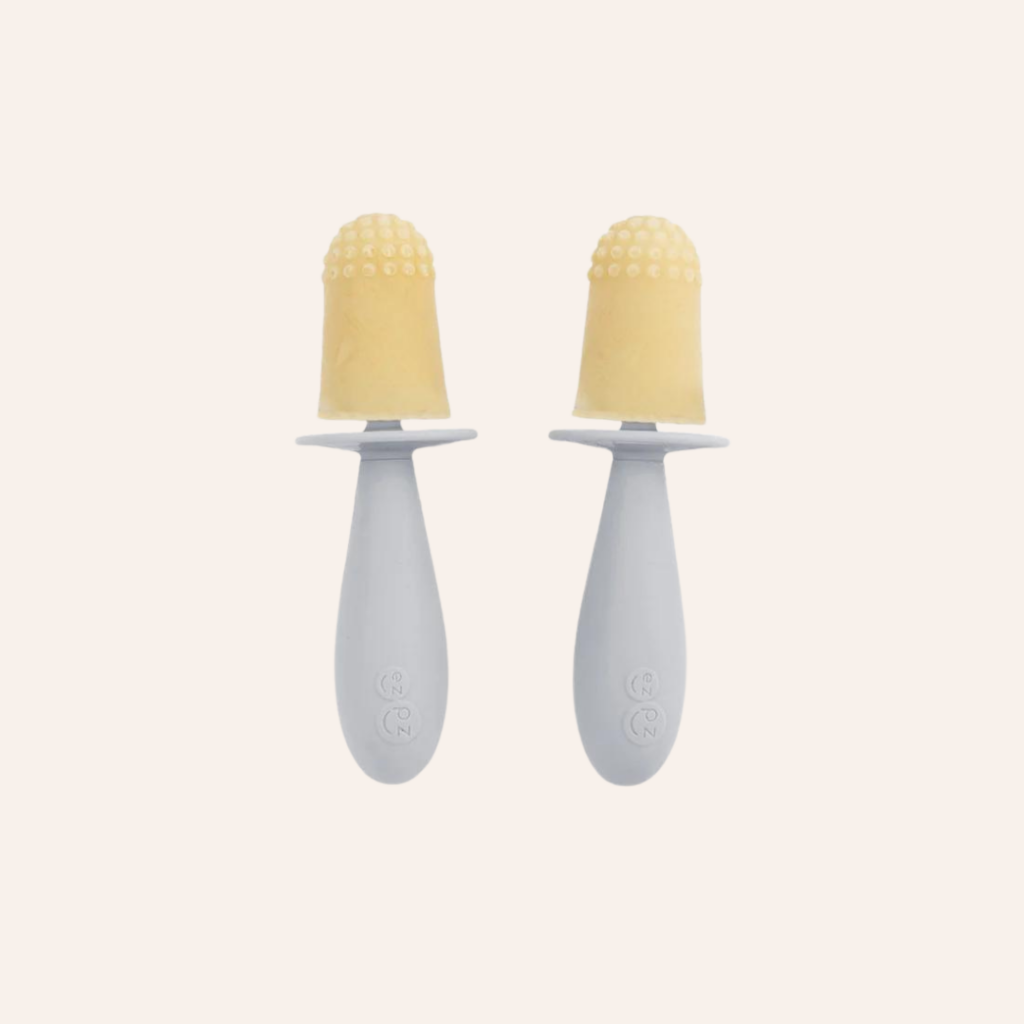
This can help build your baby’s chewing skills and abilities and can prevent common feeding issues such as mouth stuffing and taking huge bites of food.
Ezpz Tiny Pops
These silicone popsicle molds were created specifically for babies. They hold ½ oz which is the perfect size to fit your baby’s small mouth. The Tiny Pops have short, round handles which are easier for your baby to hold onto.
What’s even better is this popsicle mold was designed by a Pediatric Feeding Specialist. It has tiny little frozen sensory bumps on the top of the popsicle to provide increased oral awareness and stimulation for your baby.

This can help build your baby’s chewing skills and abilities and can prevent common feeding issues such as mouth stuffing and taking huge bites of food.
Munchkin Fresh Food Freezer Pops
These BPA-free plastic popsicle molds are great for babies as the molds are nice and wide making them the perfect size.
They’re also designed to have an easy-grip ring handle to make it easier for your baby to hold onto. Bonus – they have a drip catcher to help prevent messes when the popsicle melts!
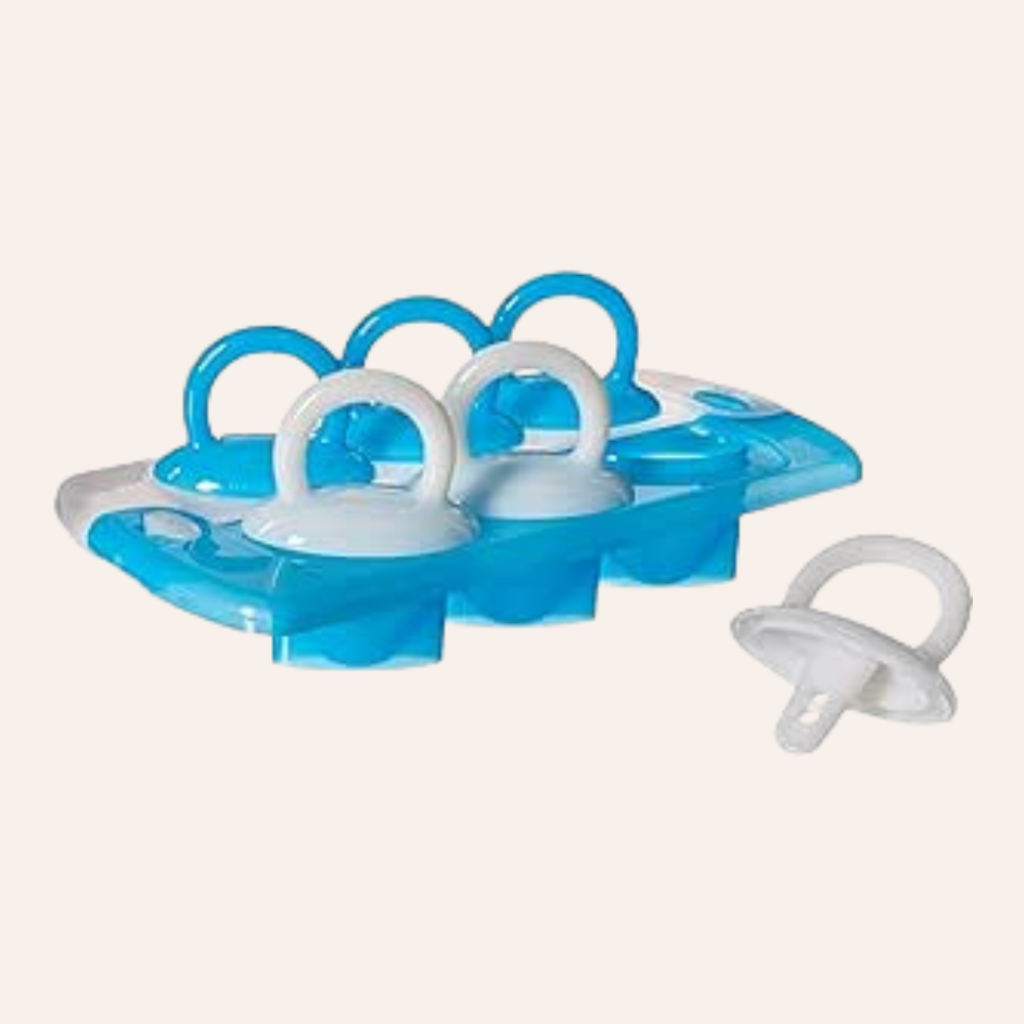
Munchkin Fresh Food Freezer Pops
These BPA-free plastic popsicle molds are great for babies as the molds are nice and wide making them the perfect size.
They’re also designed to have an easy-grip ring handle to make it easier for your baby to hold onto. Bonus – they have a drip catcher to help prevent messes when the popsicle melts!

Nuby Garden Fresh Fruitzicle Frozen Pop Tray
These BPA-free plastic popsicle molds are a great size for babies, and the sturdy ring handles will make it easy for your baby to hold onto. The wide popsicle-holder base also catches drips as the popsicle melts to help reduce the mess.
The only downside is due to the hard plastic molds, some people have found it difficult to remove the popsicles from the plastic mold after taking them out of the freezer. It can help to quickly run them under warm water.
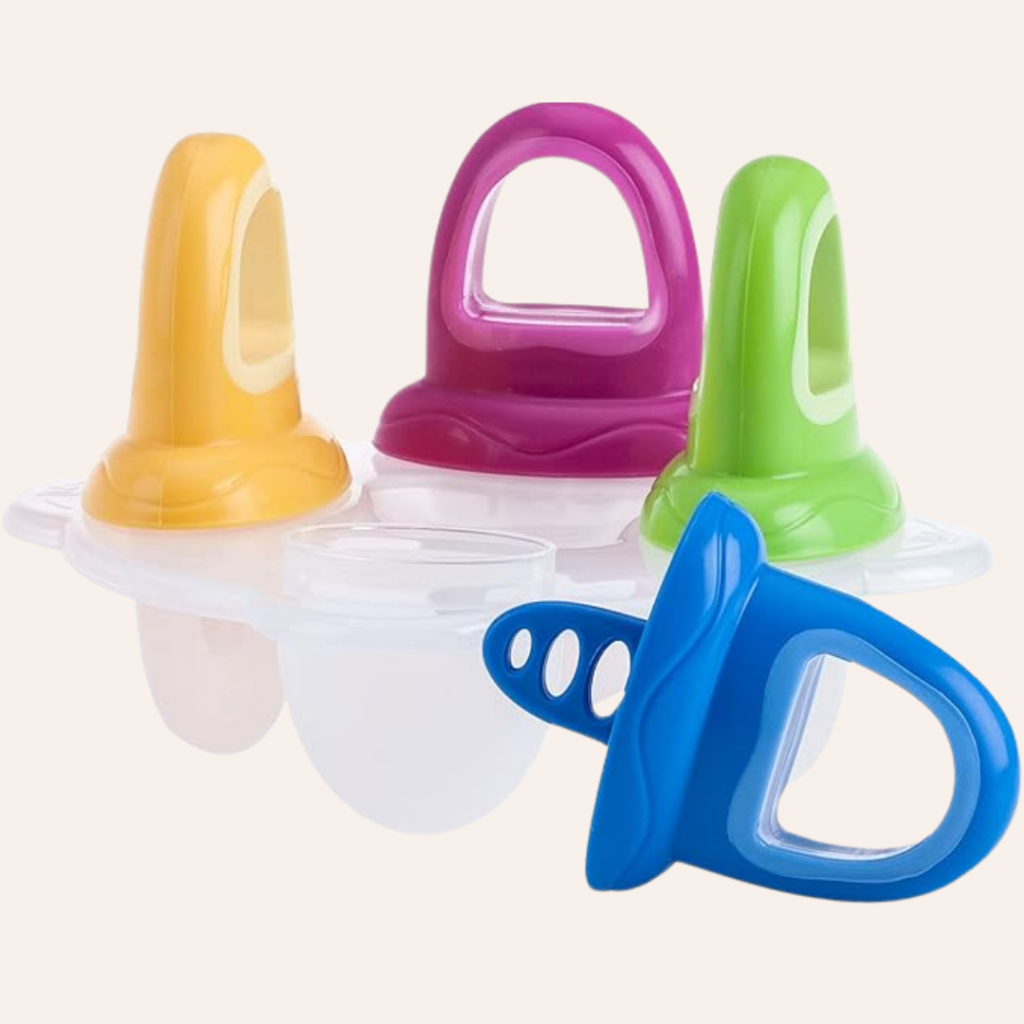
Nuby Garden Fresh Fruitzicle Frozen Pop Tray
These BPA-free plastic popsicle molds are a great size for babies, and the sturdy ring handles will make it easy for your baby to hold onto. The wide popsicle-holder base also catches drips as the popsicle melts to help reduce the mess.
The only downside is due to the hard plastic molds, some people have found it difficult to remove the popsicles from the plastic mold after taking them out of the freezer. It can help to quickly run them under warm water.

Silicone Popsicle Molds
These fun-colored silicone popsicle molds are a great option for kids!
However, they may not be suitable for young babies due to the small handles and larger popsicle size making them too heavy and difficult for young babies to hold. These may be more suitable for older babies or toddlers.
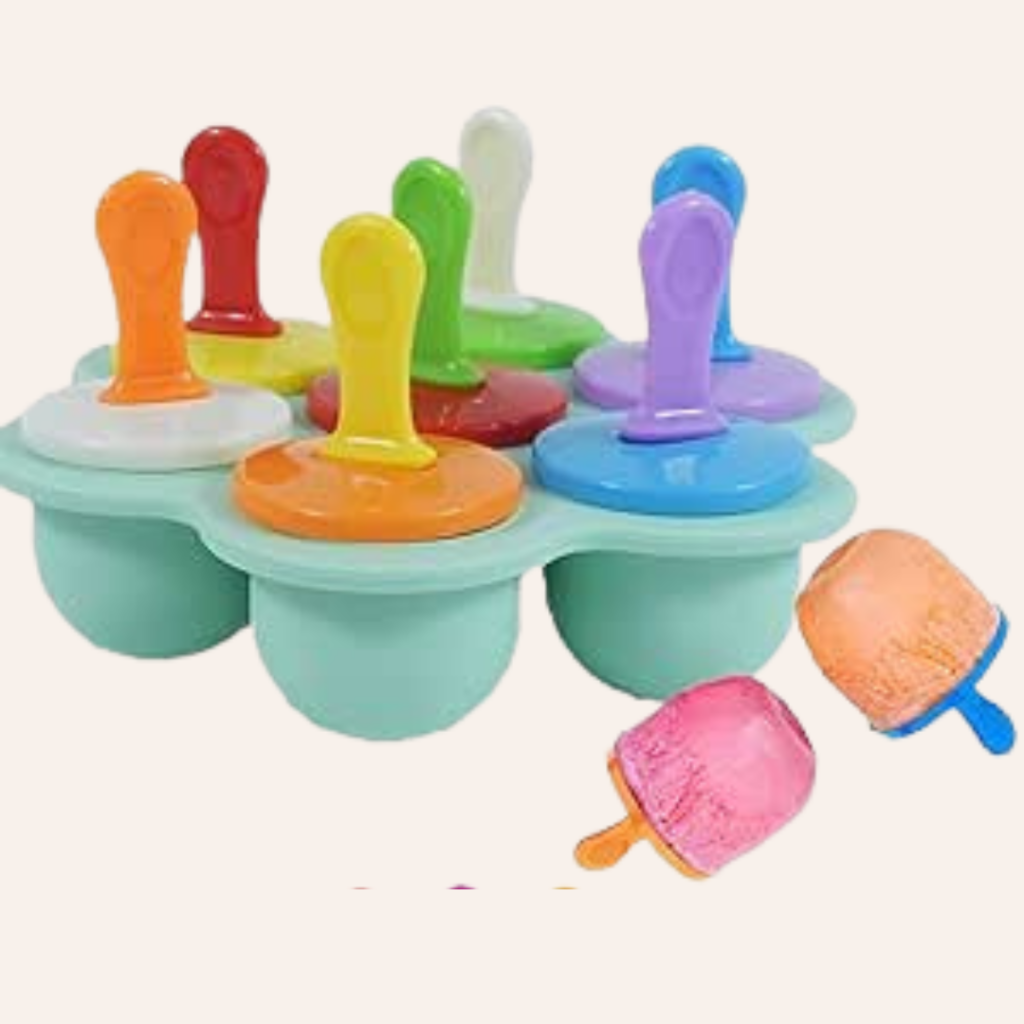
Silicone Popsicle Molds
These fun-colored silicone popsicle molds are a great option for kids!
However, they may not be suitable for young babies due to the small handles and larger popsicle size making them too heavy and difficult for young babies to hold. These may be more suitable for older babies or toddlers.

Are store-bought popsicles safe for babies?
The issue with store-bought popsicles is that they often contain added sugars as some of the first ingredients. You may see these in the ingredient list as sugar, glucose, or concentrated fruit juice.
Furthermore, the amount of added sugar in popsicles is often really high. And since we recommend avoiding any added sugars until 2 years of age, we definitely want to avoid products that are really high in added sugars.
Because of this, we recommend avoiding most store-bought popsicles until at least 2 years of age.
That said, it is possible to find store-bought popsicles that are good options for babies.
We want to look for a popsicle that contains no added sugars and comes in a size that is baby-appropriate. Store-bought popsicles are often large in size with small wooden handles which babies find very difficult to hold and feed to themselves because of how large and heavy they are, as discussed above when choosing our top popsicle molds.
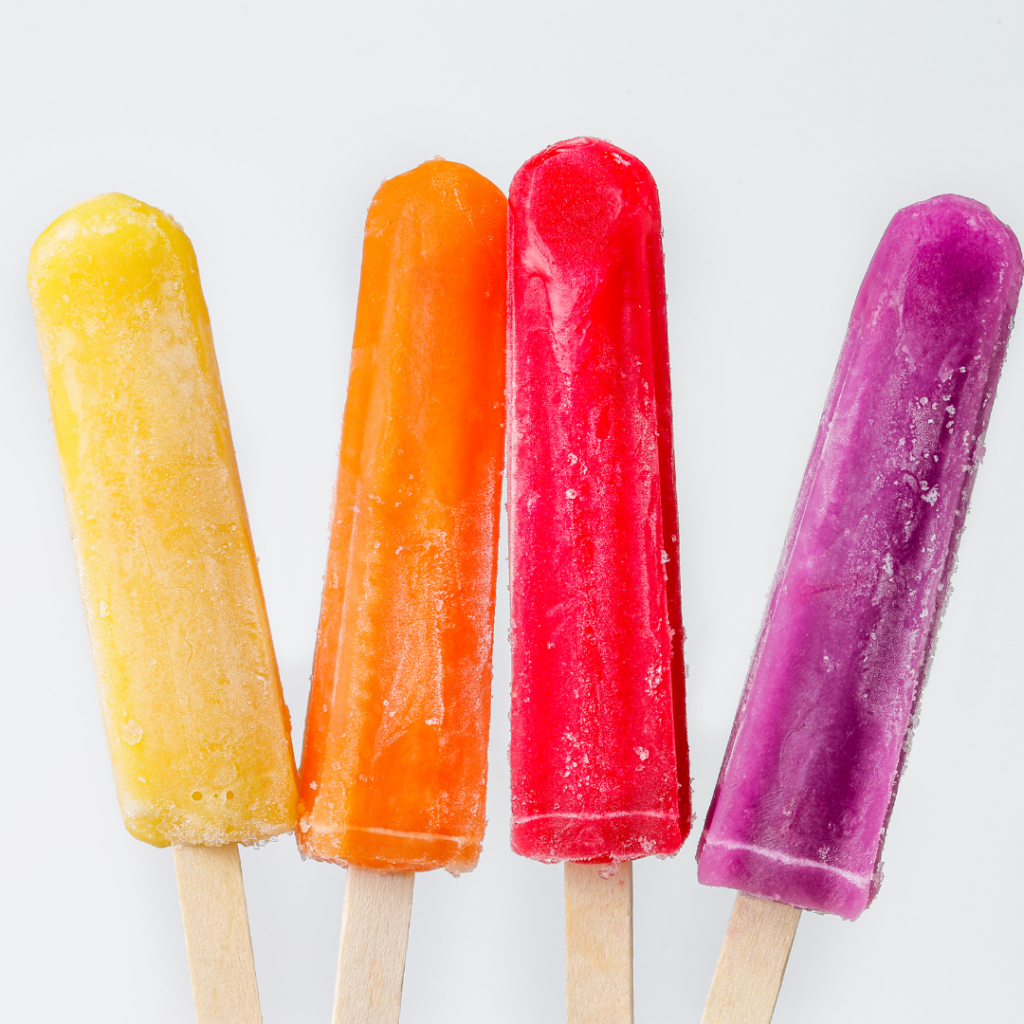
Search for something smaller or with a wider/thicker handle that would be easy for a baby to grip with their palmar grasp.
Recommended store-bought popsicles for babies
If you would like to buy a popsicle from a store, we recommend popsicles that use whole ingredients or have only 100% fruit juice with no other added sugars. Below are our recommended store-bought popsicle brands for babies.
nomzicles
nomz popsicles have four simple ingredients: cashews, dates, fair trade cocoa, and spring water. These ingredients are safe and healthy for babies, making these an appropriate popsicle option to buy for your little one.
The nomz popsicles are unlike other popsicles as they don’t have a handle to hold onto. After tearing the top of the popsicle wrapper, you can push the popsicle up and use the wrapper to hold it.
The nomz popsicles are large popsicles which may be too heavy and hard for your baby to hold. Your baby will likely be unable to push the popsicle out of the wrapper, so they may need your help to do this and to help them hold it.
Use code MYLITTLEEATER15 for 15% off!
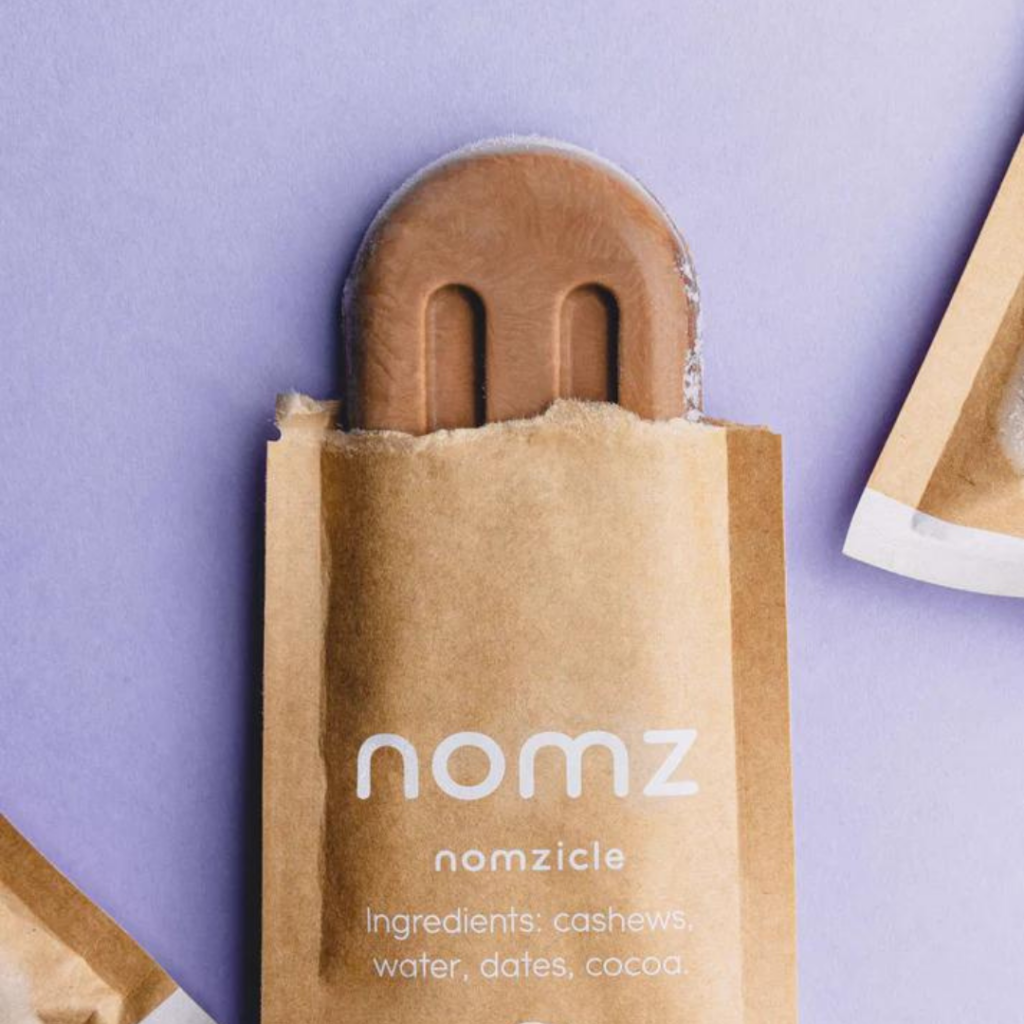
nomzicles
nomz popsicles have four simple ingredients: cashews, dates, fair trade cocoa, and spring water. These ingredients are safe and healthy for babies, making these an appropriate popsicle option to buy for your little one.

The nomz popsicles are unlike other popsicles as they don’t have a handle to hold onto. After tearing the top of the popsicle wrapper, you can push the popsicle up and use the wrapper to hold it.
The nomz popsicles are large popsicles which may be too heavy and hard for your baby to hold. Your baby will likely be unable to push the popsicle out of the wrapper, so they may need your help to do this and to help them hold it.
Use code MYLITTLEEATER15 for 15% off!
DeeBee’s Organics Freezie Pops
DeeBee’s Organic Freezer Pops are organic, vegan, gluten-free, have no artificial colors, flavors, or preservatives, and are made with 100% fruit juice.
Deebee’s states that their popsicles are safe treats for babies 6 months and older. Many parents have found these popsicles to be great for their teething baby. As always, they recommend supervising your baby when eating them.
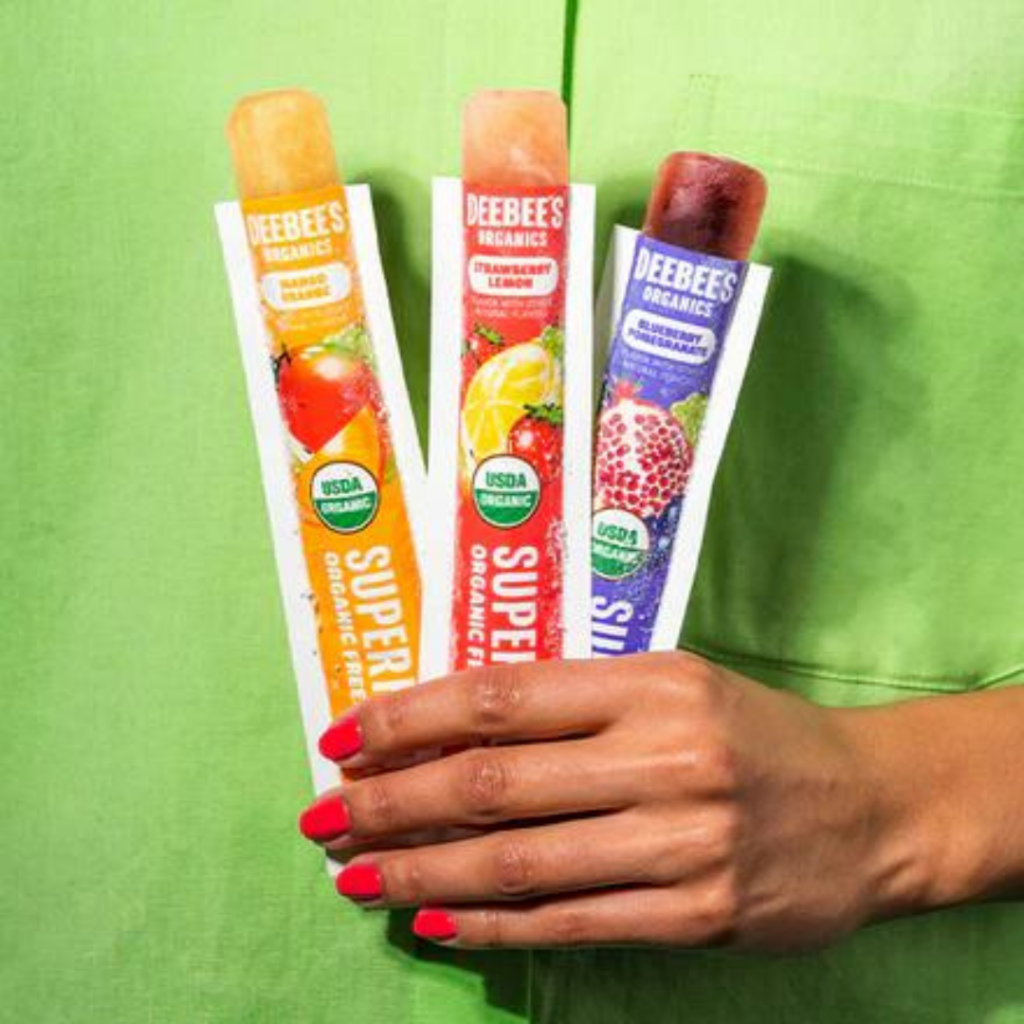
DeeBee’s Organics Freezie Pops
DeeBee’s Organic Freezer Pops are organic, vegan, gluten-free, have no artificial colors, flavors, or preservatives, and are made with 100% fruit juice.

Deebee’s states that their popsicles are safe treats for babies 6 months and older. Many parents have found these popsicles to be great for their teething baby. As always, they recommend supervising your baby when eating them.
And that’s it! As you can see, there aren’t many appropriate store-bought popsicle options for babies. We recommend avoiding most store-bought popsicles until at least 2 years of age.
If you know of any others, please send us an email so we can check them out. We’re always looking for brands that are providing parents with convenient and healthy options for their babies. In the meantime, at least there are a couple of options you can try with the 9 healthy recipes we provided above too!
Benefits of popsicles for babies
You may be surprised that we’re so encouraging of serving your baby popsicles for snacks (and even meals!) but there are actually so many benefits of homemade popsicles for your baby that we can’t overlook them!
Nutrient-dense
With homemade popsicles, you can control the ingredients and pack them with nutrition for your baby. Homemade popsicles can be a healthy snack or even a healthy breakfast for your little one (very similar to our stance on smoothies and smoothie bowls as meals).
Yes, you heard that right – breakfast!
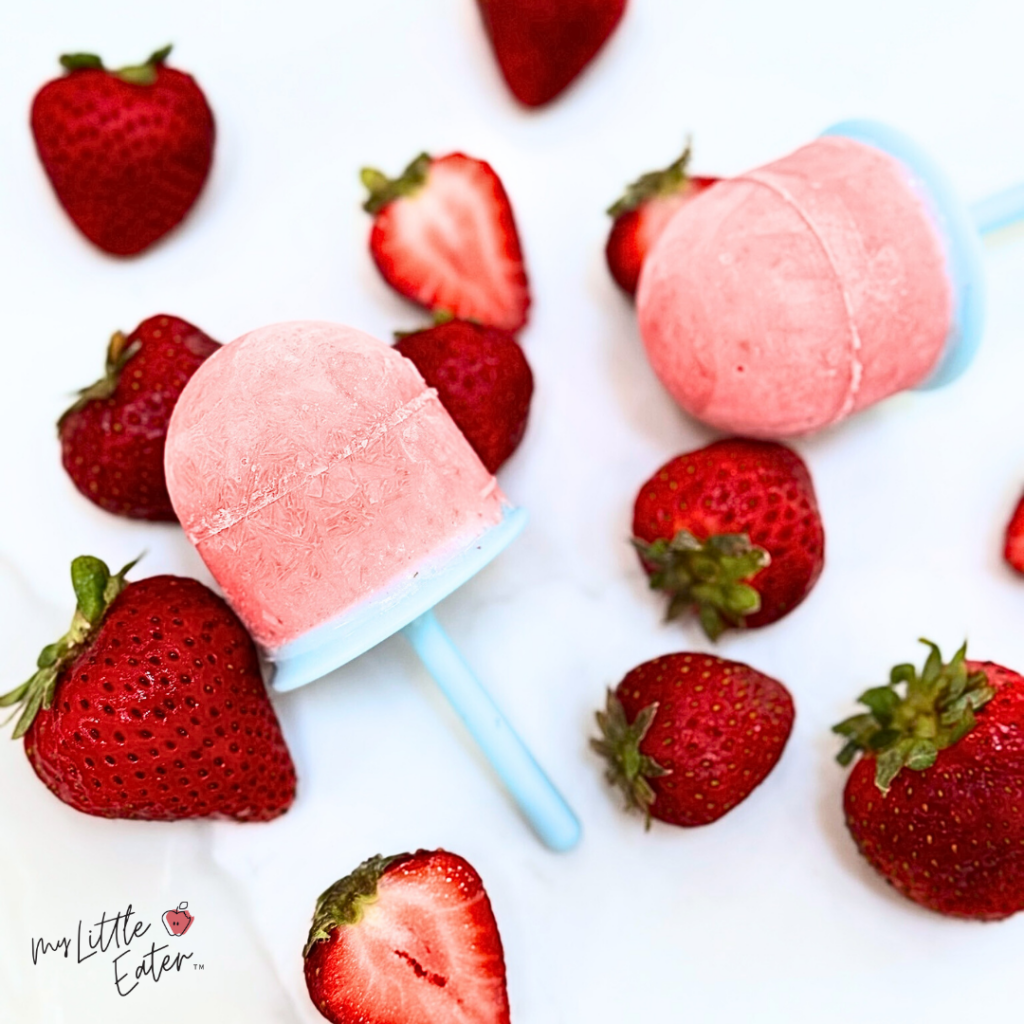
Who wouldn’t want a refreshing popsicle for breakfast on a hot summer day? Delicious, healthy, and – bonus – they’re super easy to make! Popsicles can be an easy and low-pressure way to make mealtimes fun for your baby or toddler.
We’ll note that even though popsicles are often treats that us adults can eat on the go while walking, we still recommend sitting your baby down in a safe feeding environment to eat the popsicle.
Novel flavors and textures
Our signature formula for making popsicles will help you make endless popsicle recipes for your baby to try. This means you can expose your baby to a variety of foods, flavors, and textures in a fun and exciting way early on in life.
It’s also super easy to mix up the ingredients to help encourage the development of eating skills and acceptance of new foods.
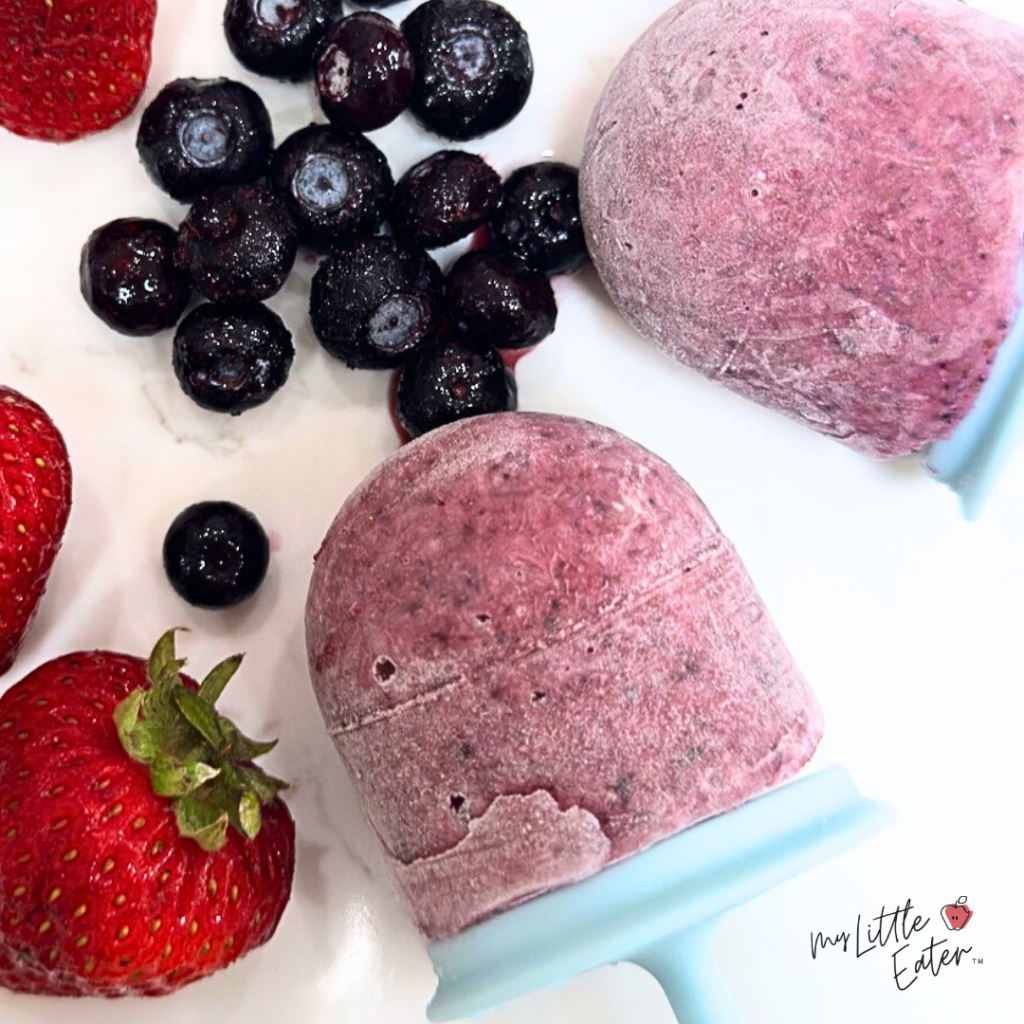
Soothes sore gums from teething
Popsicles can help soothe sore gums and provide pain relief for your teething baby. The pressure from babies gnawing on a popsicle and the cold temperature of a popsicle can help reduce inflammation in the gums and soothe the pain caused by teething (8, 9).
Hydration
Babies are more susceptible than adults to dehydration. When your baby is sick or during the hot summer months, you need to be extra cautious that your baby is well-hydrated.
In addition to serving limited water to your baby, we recommend offering breast milk or formula frequently as a drink for babies under 1 year of age to help keep them hydrated. Popsicles, especially ones made with breast milk or formula, are a great option to offer your little one as a cool treat to help them stay hydrated as well.
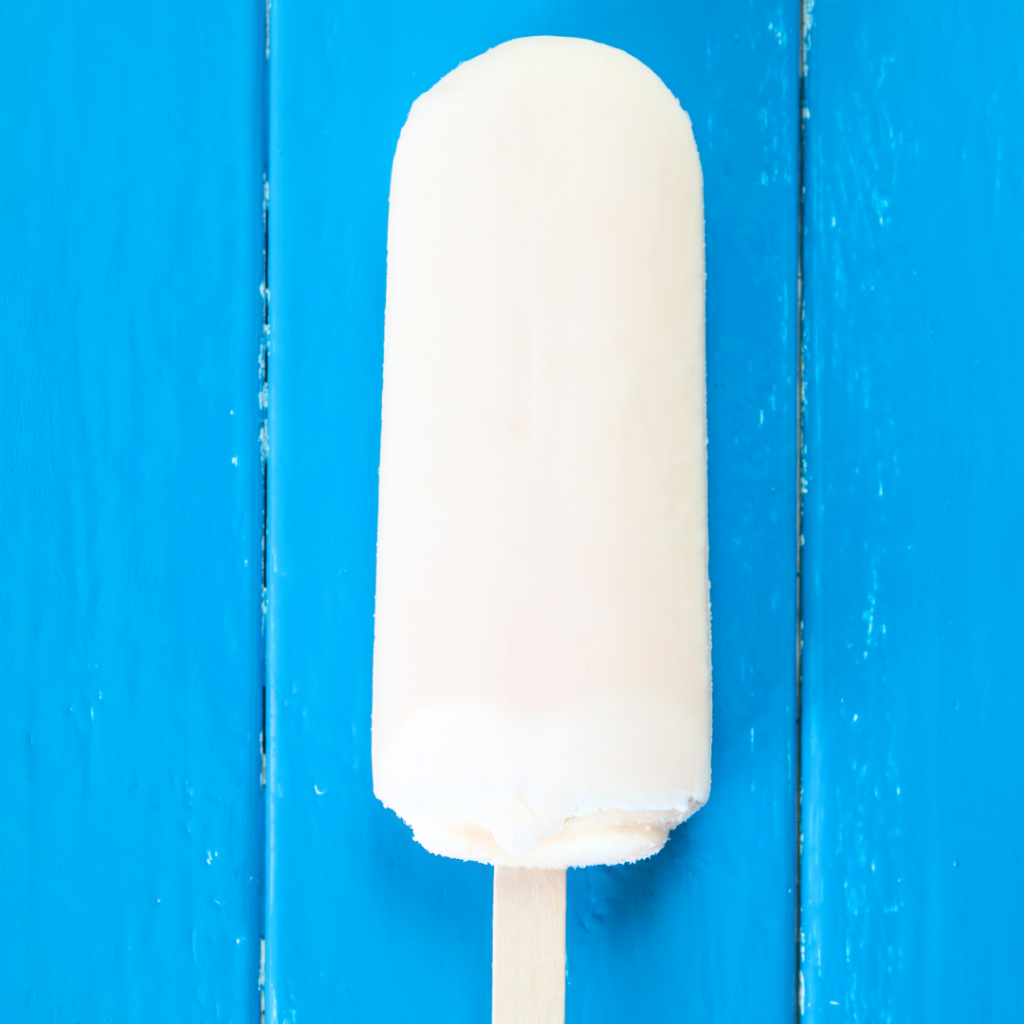
Increases oral awareness
Top tip from our expert Speech Language Pathologist, Mallory Roberts – cold items can help to increase your baby’s oral awareness so they can “feel” all the spaces in their mouth better. Oral awareness is the ability to understand and feel food in and around the borders of the inside of the mouth.
Improving your baby’s oral awareness can help improve common learning struggles we see with babies. This includes mouth stuffing and pocketing food and can help babies learn to take smaller bites of food. Learning oral awareness begins early when starting solids, and popsicles can help improve this skill.
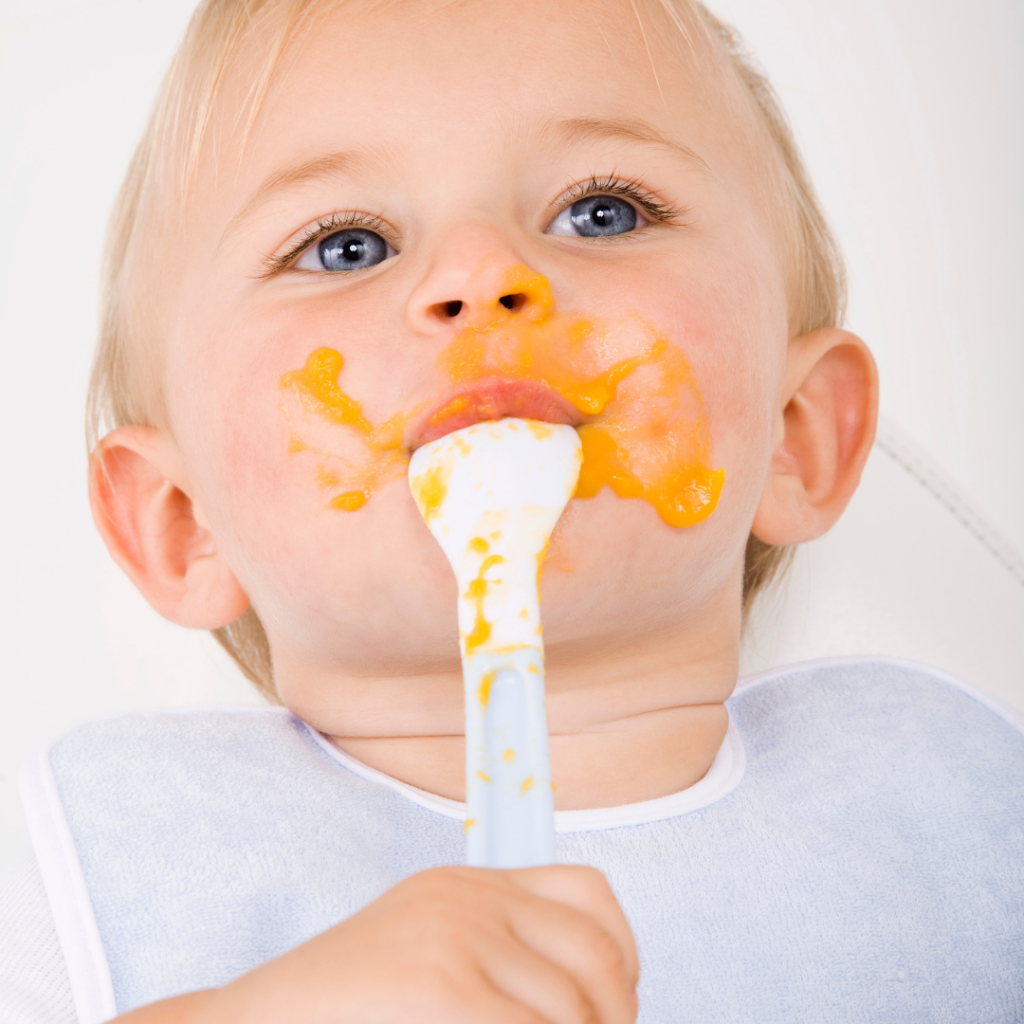
New sensory experience
Another top tip from our expert Speech Language Pathologist, Mallory Roberts – in feeding therapy, cold temperatures are often used as an added sensory change to initiate and improve swallowing. Popsicles can provide a new sensory experience in the mouth (cold temperature) to help improve your baby’s swallow.
So, if your baby’s having trouble coordinating their swallow with fast-moving liquids from an open cup or straw, cold temperatures (i.e. a popsicle!) may help initiate the swallow faster.
Perfect for the whole family
We all know that babies love to copy the actions of others. Monkey see, monkey do! If you have a toddler or older child in the family, odds are, your baby will want to eat exactly what their sibling is eating. They’ll also want to copy what you eat.
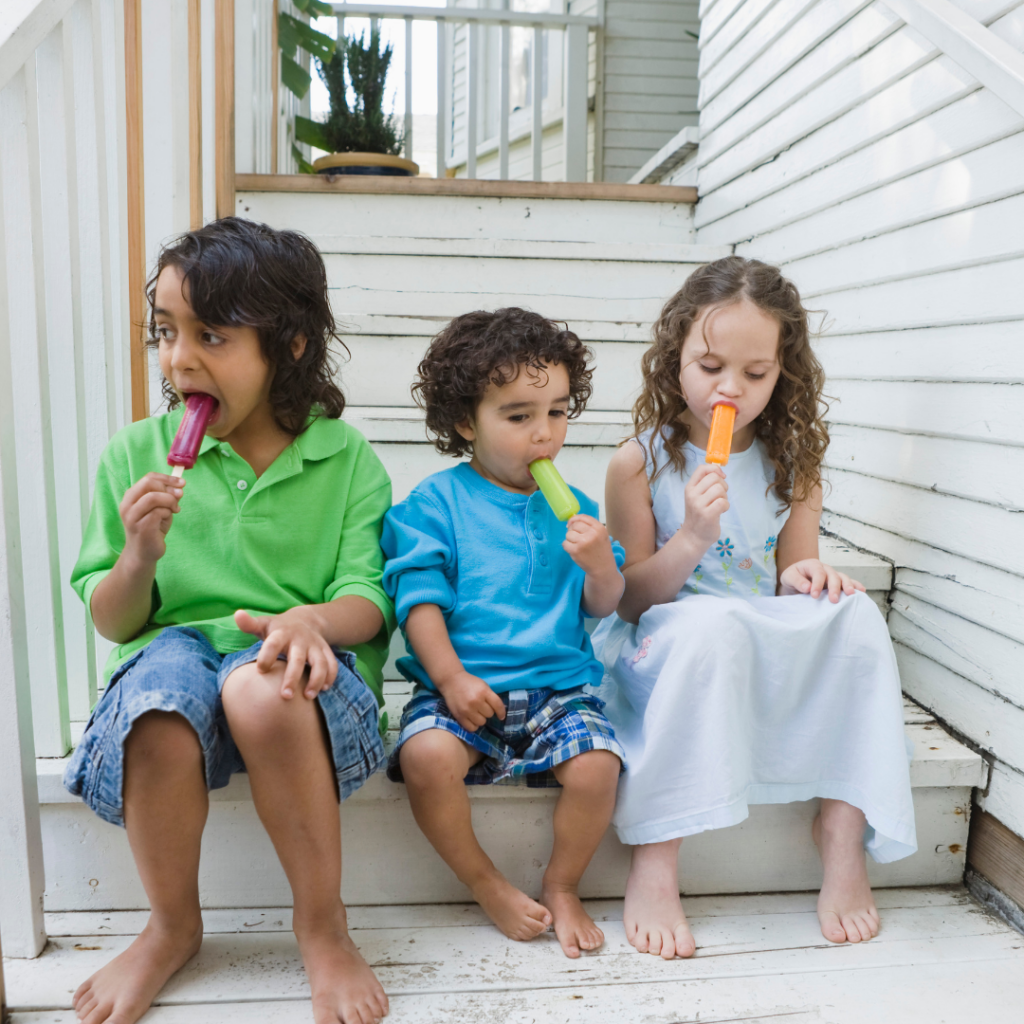
Since babies should avoid the added sugar that comes in most store-bought popsicles that a toddler or adult may be able to eat, homemade popsicles allow your baby to join in on the fun while still avoiding added sugar. Plus, the recipes we included above taste so good, they’re something that the whole family can enjoy together.
Risks of popsicles for babies
We can’t talk about the benefits without also including a list of the risks. Don’t worry though, there are more benefits than risks!
Added sugar
The freezer sections in grocery stores are flooded with endless options of pre-made popsicles. Unfortunately, as discussed already, some of the first ingredients in popsicles are typically sugar, glucose, corn syrup, and concentrated fruit juice.
In general, it’s recommended to avoid or limit added sugars for children until around 2 years of age, as mentioned above. This includes concentrated fruit juice, as the fiber and other beneficial nutrients from fruit are removed to create the concentrated juice. When this happens, the fruit juice just becomes another form of added sugar.
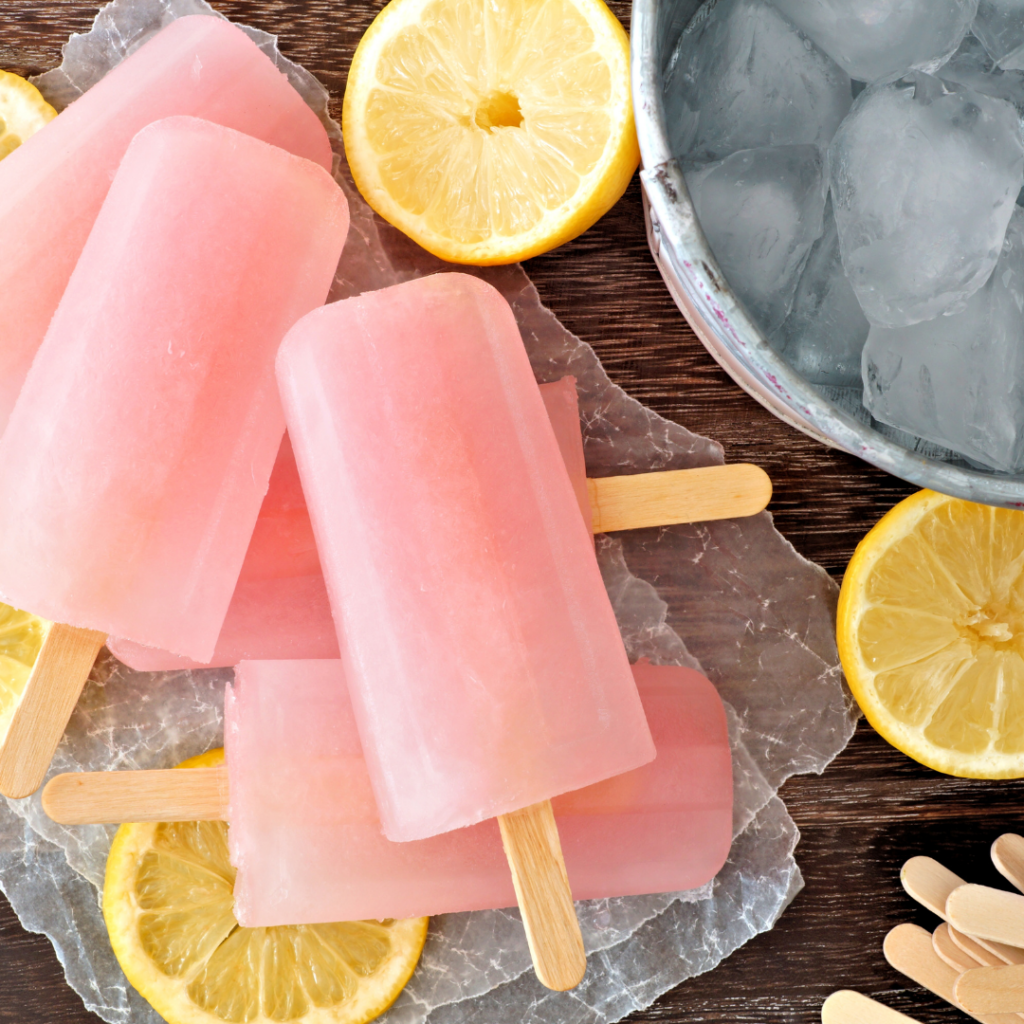
This is why although we recommend choosing store-bought popsicles made from 100% fruit juice (without other added sugars), we also recommend avoiding all store-bought popsicles until 2 years of age.
Even though 100% fruit juice is our preferred ingredient in store-bought popsicles, it’s still an added sugar that we recommend avoiding or limiting whenever possible, especially before your little one turns two.
We want to avoid added sugars for babies and toddlers under 2 because they can:
- Increase your baby’s affinity for sweet foods.
- Provide excess calories with no nutritional value.
- Raise your baby’s blood sugar levels.
Not a full meal or snack for young babies (at first!)
Popsicles are a new food for your baby and it may take some time for them to learn how to eat them, as outlined above. When first offering popsicles to your baby, they may not ingest much.
Until babies learn how to eat popsicles, the popsicle may melt and end up mostly on their highchair tray with little ending up in their belly. Your baby may become frustrated if they’re hungry and the popsicle is taking too long to melt or is not filling them up fast enough.

When first offering popsicles to your baby, you may not be able to rely on this to provide many calories or be the bulk of their meal or snack.
If your baby is still getting used to popsicles, we want to make sure your baby is still eating enough, so be sure to serve something else (that’s nutrient-dense) alongside the popsicle. This could be something as simple as full-fat yogurt, toast with nut butter, or avocado wedges rolled in iron-fortified infant cereal or hemp/flax seed.
This way, if your baby doesn’t eat the popsicle for long, or it melts and they don’t swallow much of it, no need to sweat! You can still know that your baby is getting enough calories and nutrients with the other foods that are offered.
Cold panniculitis
Another risk of popsicles for babies is the small chance of developing a condition called cold panniculitis. Cold panniculitis is the inflammation of fat tissue underneath the skin related to exposure to the cold (10). While this condition is rare, it is more common in young children as their fat stores are more susceptible to the cold (10, 11).
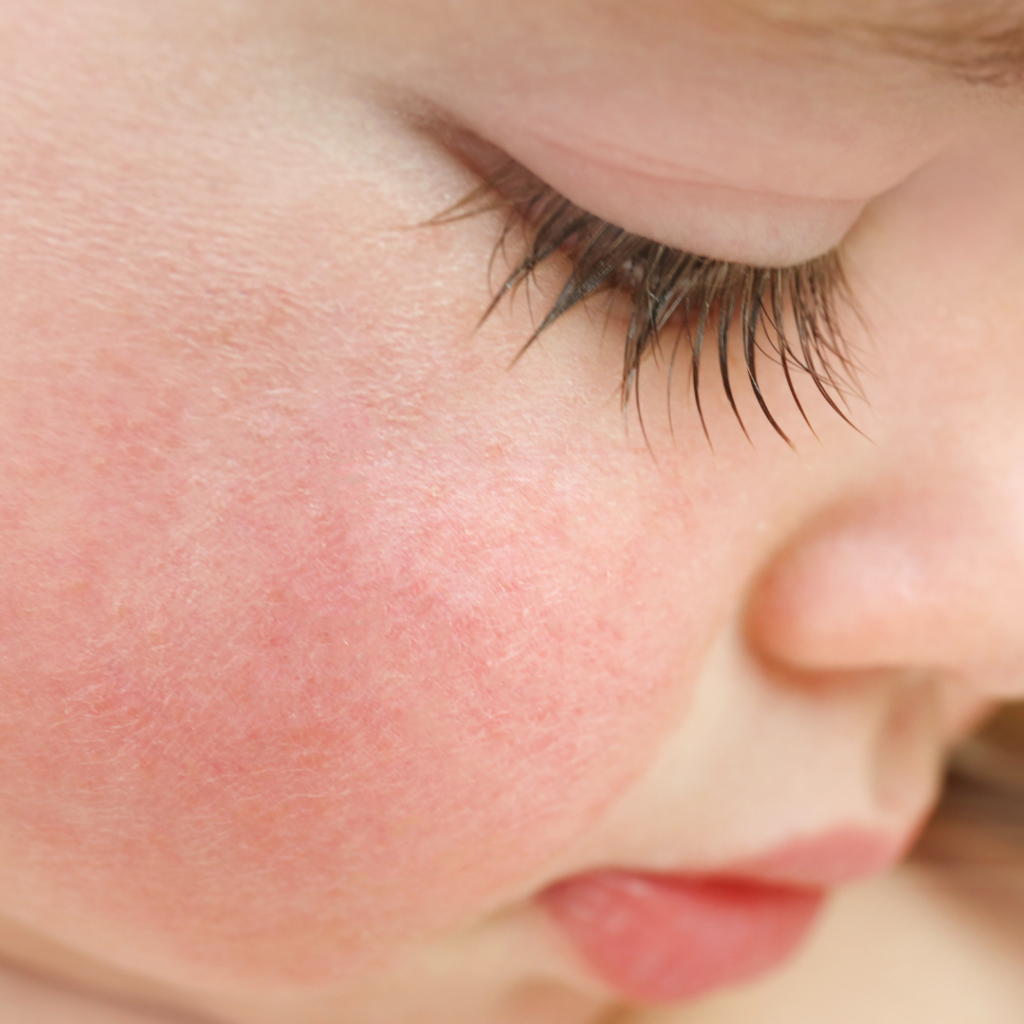
Cold panniculitis often develops in the cheeks 48 to 72 hours after being exposed to very cold temperatures, including cold weather, ice bags, or after eating a popsicle (called “popsicle panniculitis”) (11). You might see redness, swelling, and bumps on the cheeks or chin of your baby.
If your child develops cold panniculitis, don’t worry! Symptoms usually go away on their own within 2-3 weeks. If your baby develops this after eating a popsicle, it’s recommended to avoid popsicles until they are better tolerated by your little one (12).
Popsicles may cause coughing
Popsicles may cause light gagging or coughing in your baby. Popsicles offer a new texture and temperature for your baby and may be the first food your baby has eaten that starts as a solid and then gradually melts into a liquid.
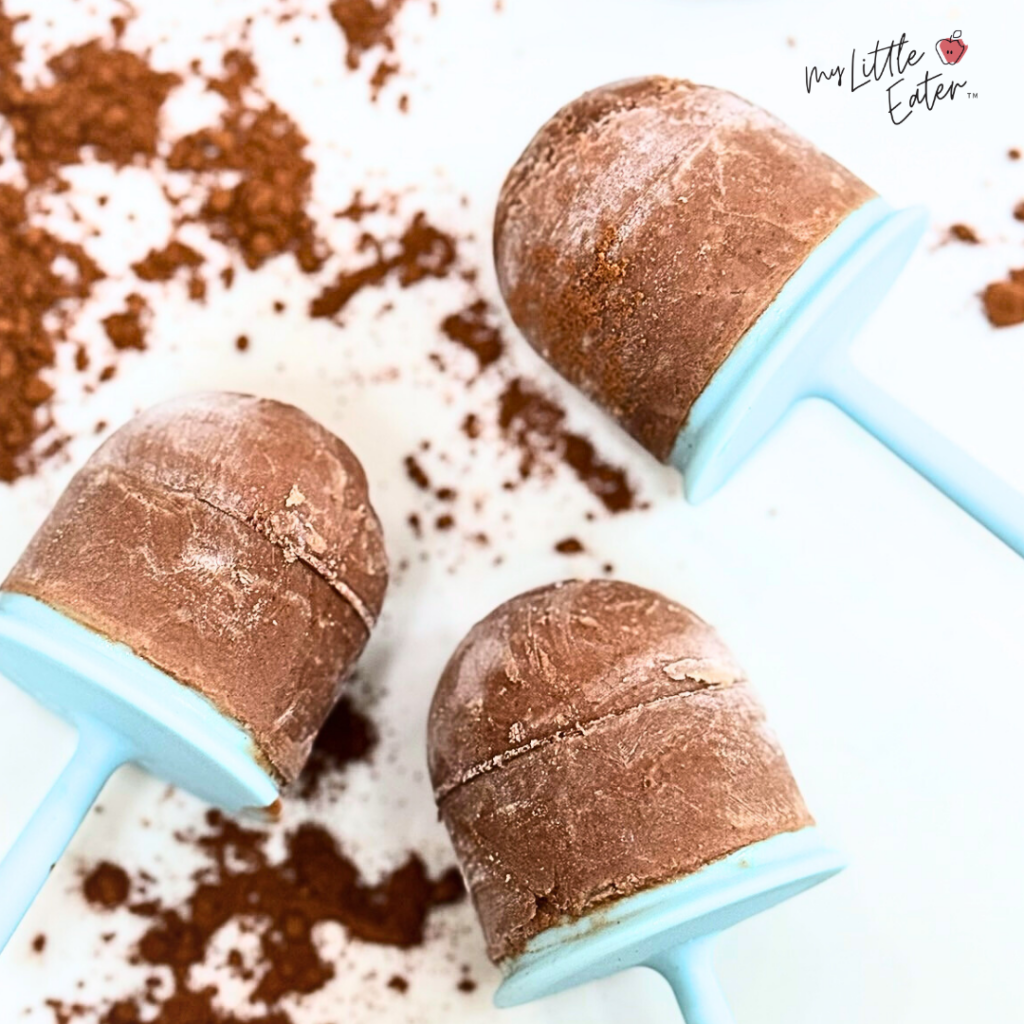
Chances are, the popsicle will melt slowly and your baby may not even ingest much at first. But the liquid may cause your baby to cough or gag. This isn’t a risk, just something to be mindful of and prepared for as they learn to handle this new sensory experience.
Baby Popsicle FAQs
How often can babies have homemade popsicles?
Popsicles should be treated like any other food. We don’t want to offer the same food every day. Instead, we want to mix things up to provide a variety of foods and textures for your little one to explore and be exposed to.
We would recommend no more than one popsicle per day. And if possible, avoid offering popsicles every single day or at the same time each day. This is because we want to keep your baby from becoming over-reliant on popsicles, especially during the summer months.
Offering popsicles too often as an easy snack could make your baby or toddler begin to expect them, and they may get stuck in the dreaded popsicle rut. That’s not to say popsicles can’t be a healthy option for a cool snack or treat for your little one. Just be careful not to offer them consistently so that they become expected or demanded.
Are Pedialyte Freezer Pops safe for babies?
Pedialyte recommends that the freezer pops are not appropriate for babies under 1 year old. We recommend avoiding Pedialyte freezer pops until your child is 2 years or older due to the added sugars in the ingredients. If you’d like to offer Pedialyte to your baby under 2 years old, you need to consult your doctor first.
Can I give my baby a mesh teether?
We recommend waiting to offer your baby a mesh feeder with food in it until they’re ready to start solids, which is generally around 6 months of age. Some mesh feeders come with small trays for freezing food/liquids in and then can be added to the mesh feeder pouch once frozen.
For these mesh feeders, the popsicle recipes in this blog would be able to be added to the trays to freeze and then can be added to the mesh feeder for your baby to gnaw on.
Can I add breast milk or formula to popsicles for babies?
How do you make formula or breast milk popsicles for your baby?
Pure breast milk or formula popsicles are great for teething babies to gnaw on or to provide extra hydration to your little one. You can also give the popsicle to your baby to suck on as a way to explore the boundaries of their mouth.
These popsicles are very simple to make – just add breast milk or formula into the popsicle molds and freeze. Once they’re firm, they’re all set for your baby to enjoy.
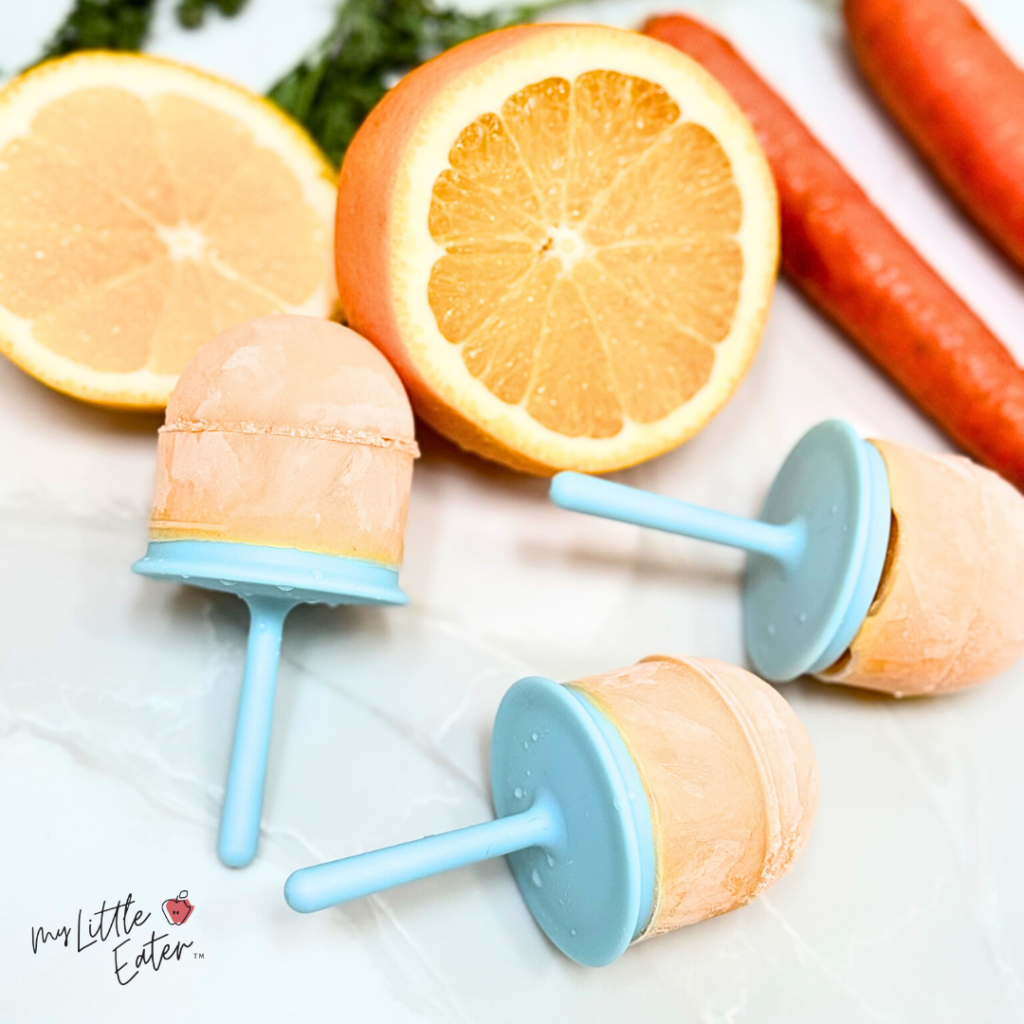
Now that you’re an expert in all things popsicles for your baby, we hope that you can enjoy the deliciousness that comes with it! We can’t wait for you to experience the joy of offering a popsicle to your baby and seeing their reaction to this brand-new sensory experience.
Making popsicles together can be a tradition that helps to encourage your baby or toddler to have fun in the kitchen and enjoy making endless combinations of popsicle recipes.
Download our free popsicle e-book with all of the recipes shared in this blog so you can hold onto them to make with your kids summer-after-summer!
Let us know in the comments which recipe is your baby’s favorite (or your favorite)!
Was this helpful? Pin it to save for later!
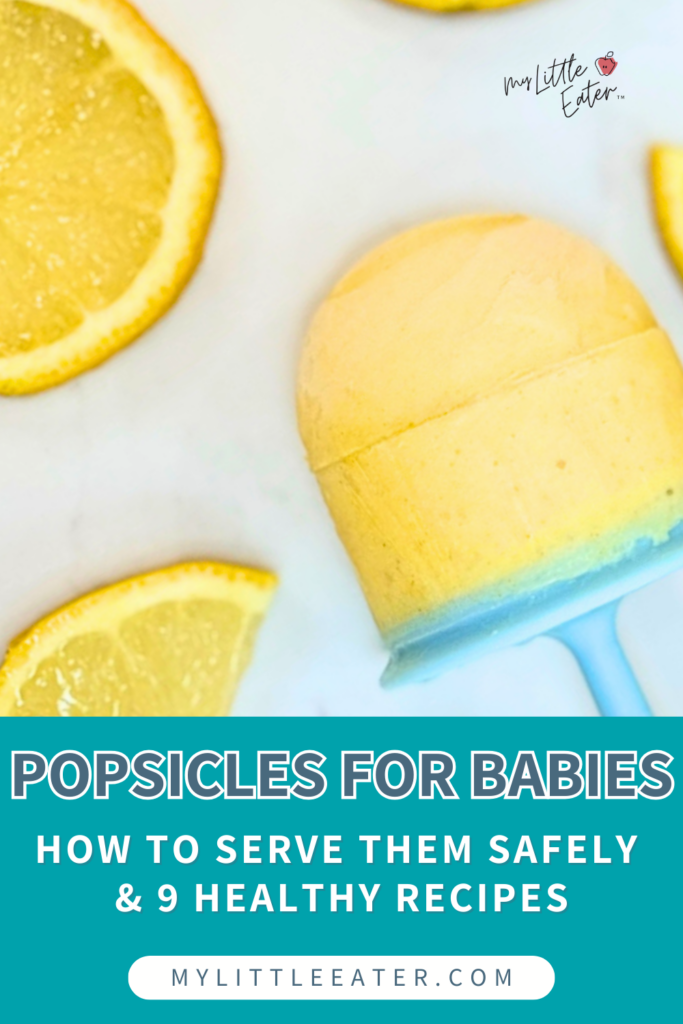
References
- World Health Organization. (n.d.). Complementary Feeding. Retrieved July 24, 2024, from https://www.who.int/health-topics/complementary-feeding#tab=tab_1
- Government of Canada. (2014, April 08). Infant nutrition. Retrieved July 24, 2024, from https://www.canada.ca/en/health-canada/services/infant-care/infant-nutrition.html
- National Institutes of Health Office of Dietary Spplements. (2023, August 17). Iron. Retrieves July 24, 2024 from https://ods.od.nih.gov/factsheets/Iron-Consumer/
- Otles, S., & Ozgoz, S. (2014). Health Effects of Dietary Fiber. Acta Scientariuym Polonorum Technlogia Alimentary, 13(2), 191-202. https://www.food.actapol.net/volume13/issue2/abstract-8.html
- Kranz, S., Brauchla, M., Slavin, J. L., & Miller, K. B. (2012). What Do We Know about Dietary Fiber Intake in Children and Health? The Effects of Fiber Intake on Constipation, Obesity, and Diabetes in Children. Advances in Nutrition, 3(1), 47-53. https://doi.org/10.3945/an.111.001362
- Mayo Clinic (2023, March 24). What is BPA, and what are the concerns about BPA? Retrieved July 24, 2024, from https://www.mayoclinic.org/healthy-lifestyle/nutrition-and-healthy-eating/expert-answers/bpa/faq-20058331
- Glory Sun Group. (2022, February 15). How to distinguish food-grade silicone and regular silicone? Retrieved July 24, 2024, from https://www.glorysungroup.com/blog/food_grade_silicone
- Pradhan, M., Joshi, U., Mathema, S., Neupane, A., Thakuri, R. S., Poudyal, S., Chaulagain, R. (2020). Parents’ Beliefs and Practices on Teething. JNDA, 20(2), 100-106. https://www.researchgate.net/profile/Rajib-Chaulagain/publication/347561060_Parents%27_Beliefs_and_Practices_on_Teething/links/5fe1e4c7a6fdccdcb8efe62d/Parents-Beliefs-and-Practices-on-Teething.pdf
- Karjiker, Y. I., & Morkel, J. A. (2020). Teething symptoms and management during infancy – A narrative review. South African Dental Journal, 75(2), 87-93. https://dx.doi.org/10.17159/2519-0105/2020/v75no2a5
- Johnston, D. L., & Halton, J. M. (2007). Case 1: What a cheek! Paediatrics Child Health, 12(7), 575-578. doi: 10.1093/pch/12.7.575
- Moulonguet, I., & Fraitag, S. (2021). Panniculitis in Children. Dermatopathology, 8(3), 315-336. doi: 10.3390/dermatopathology8030037
- Greenwald, E., Chistman, M., Penn, L., Brinster, N., & Liebman, T. N. (2018). Cold panniculitis: Adverse cutaneous effect of whole-body cryotherapy. JAAD Case Rep, 4(4), 344-345. doi: 10.1016/j.jdcr.2018.02.010

Jillian Smith, RD
Registered Dietitian at My Little Eater Inc., and dog-mom to River. Jillian works behind the scenes answering nutrition questions and supporting parents of babies and toddlers to feed their little ones with confidence.

Jillian Smith, RD
Registered Dietitian at My Little Eater Inc., and dog-mom to River. Jillian works behind the scenes answering nutrition questions and supporting parents of babies and toddlers to feed their little ones with confidence.
